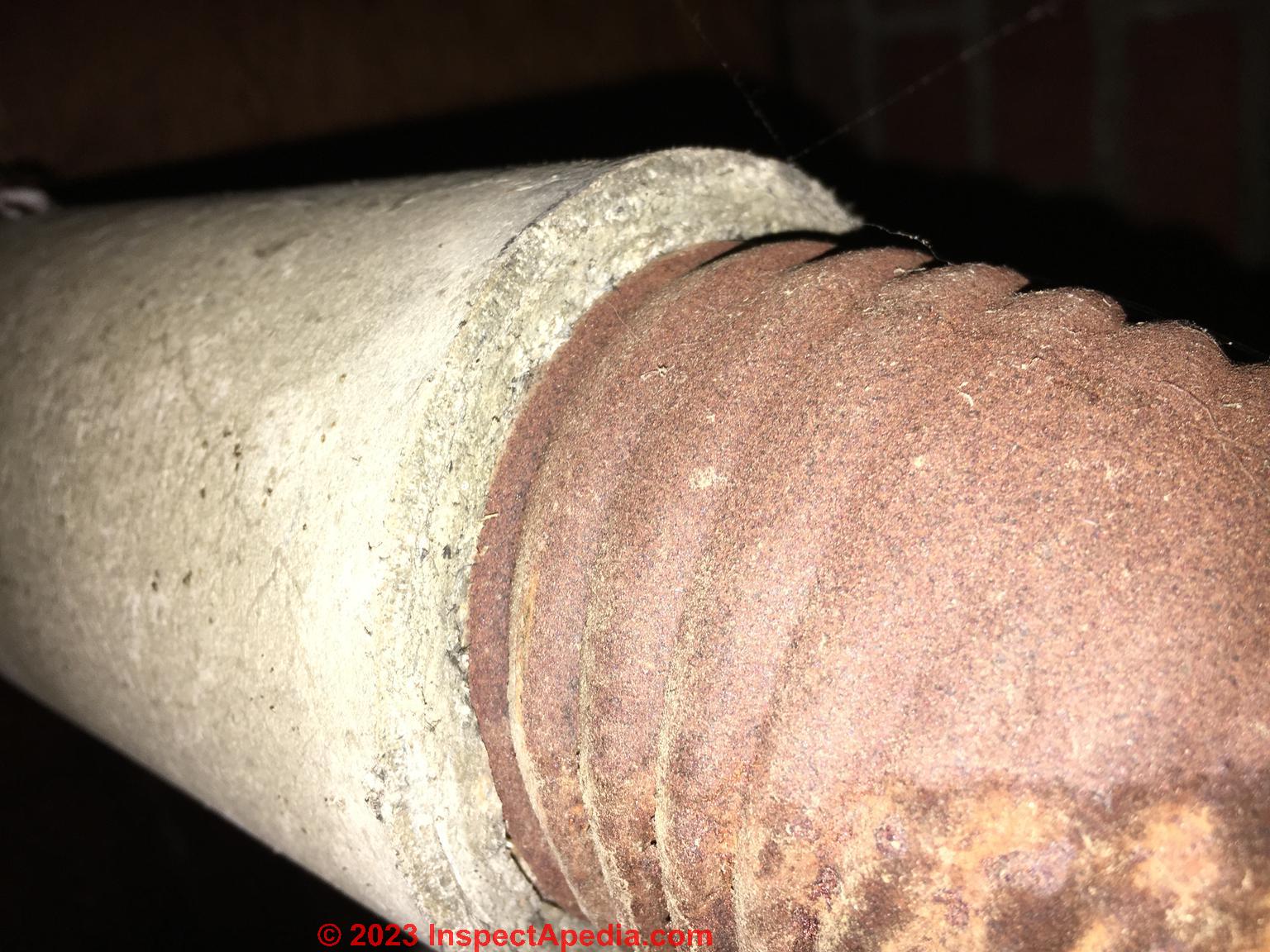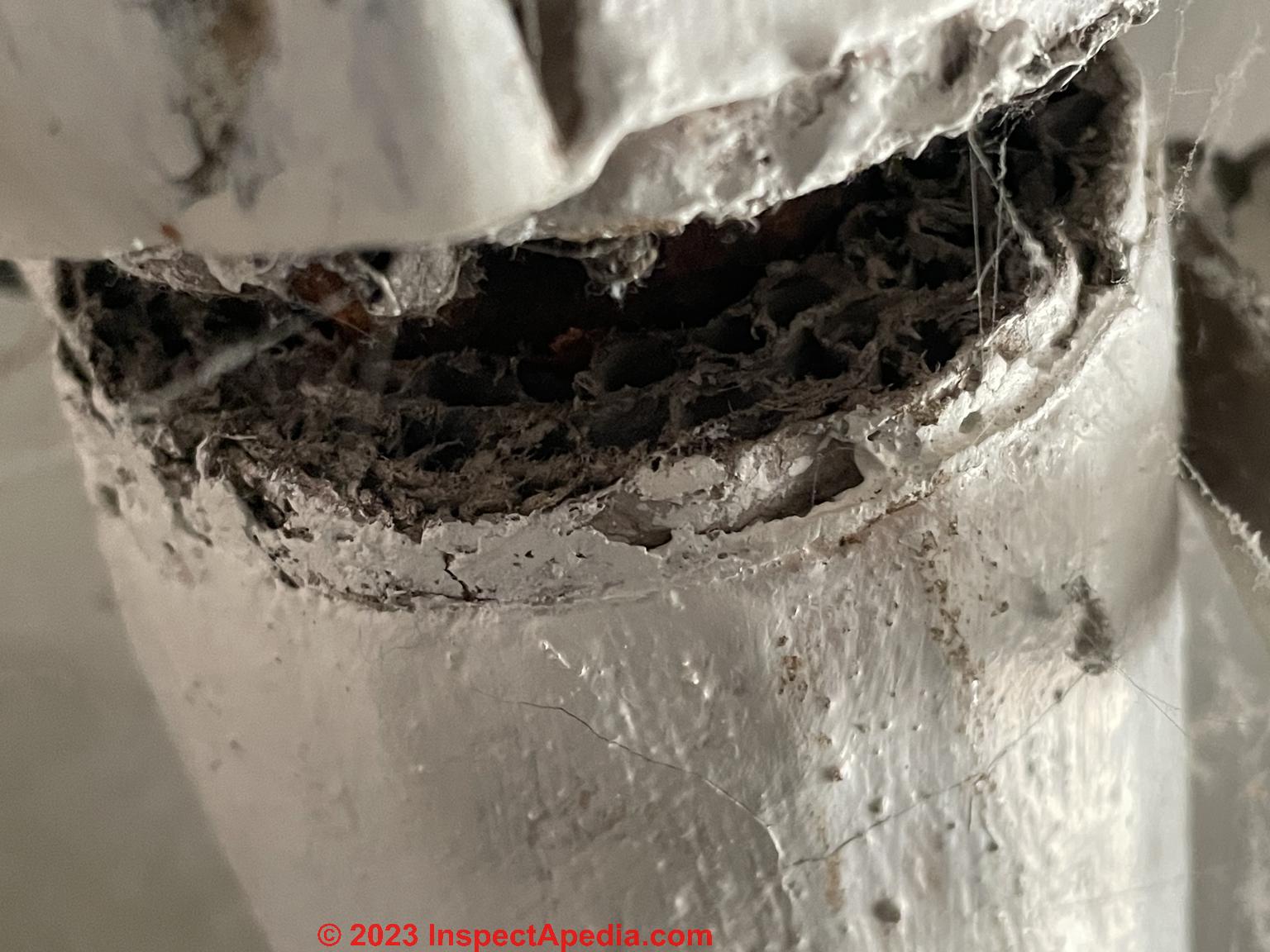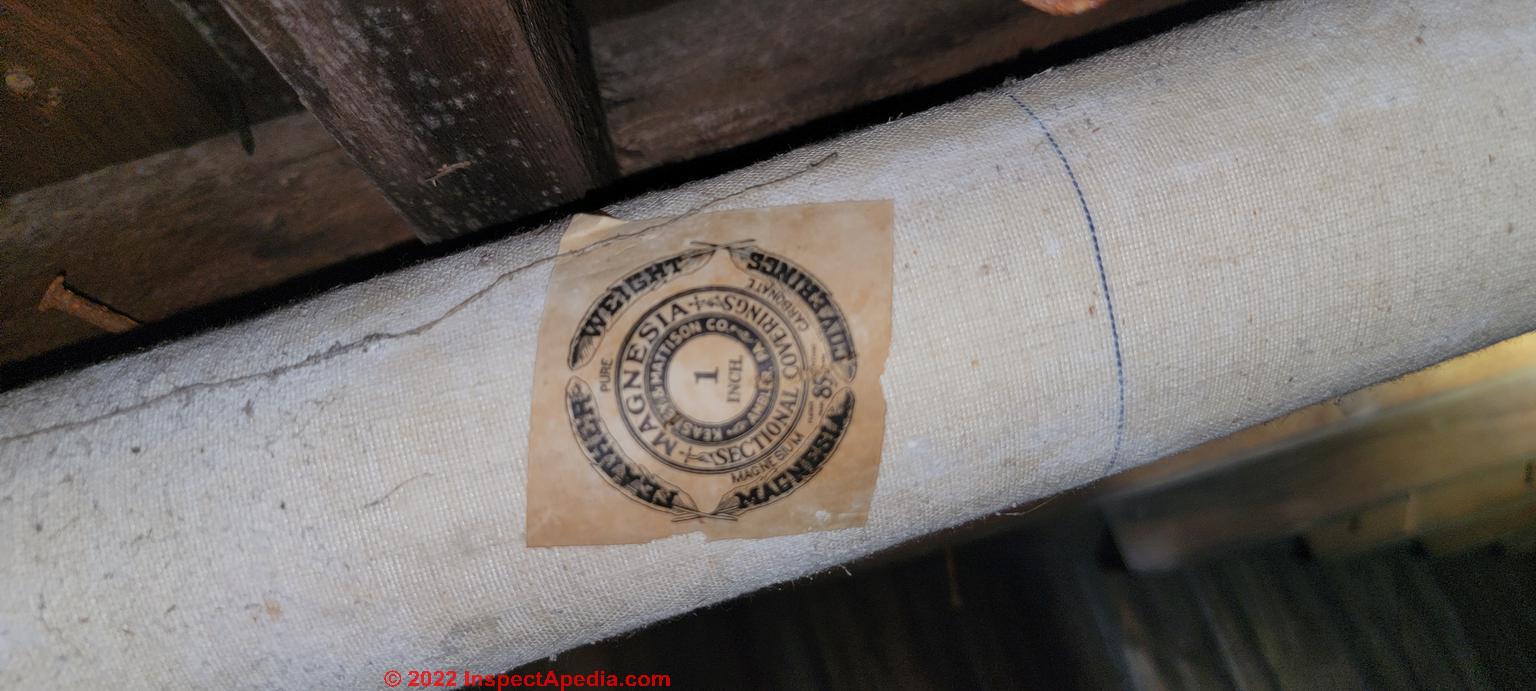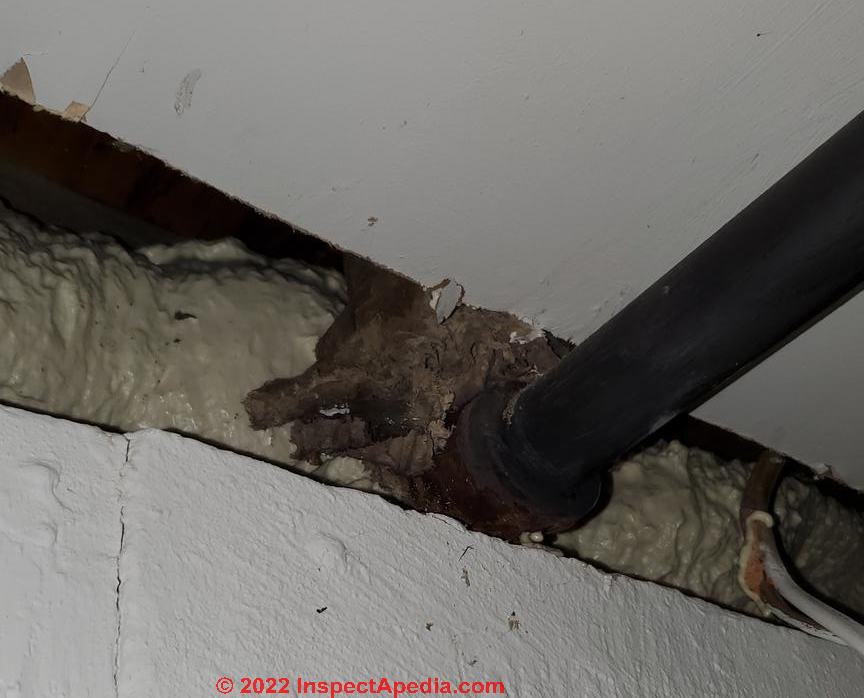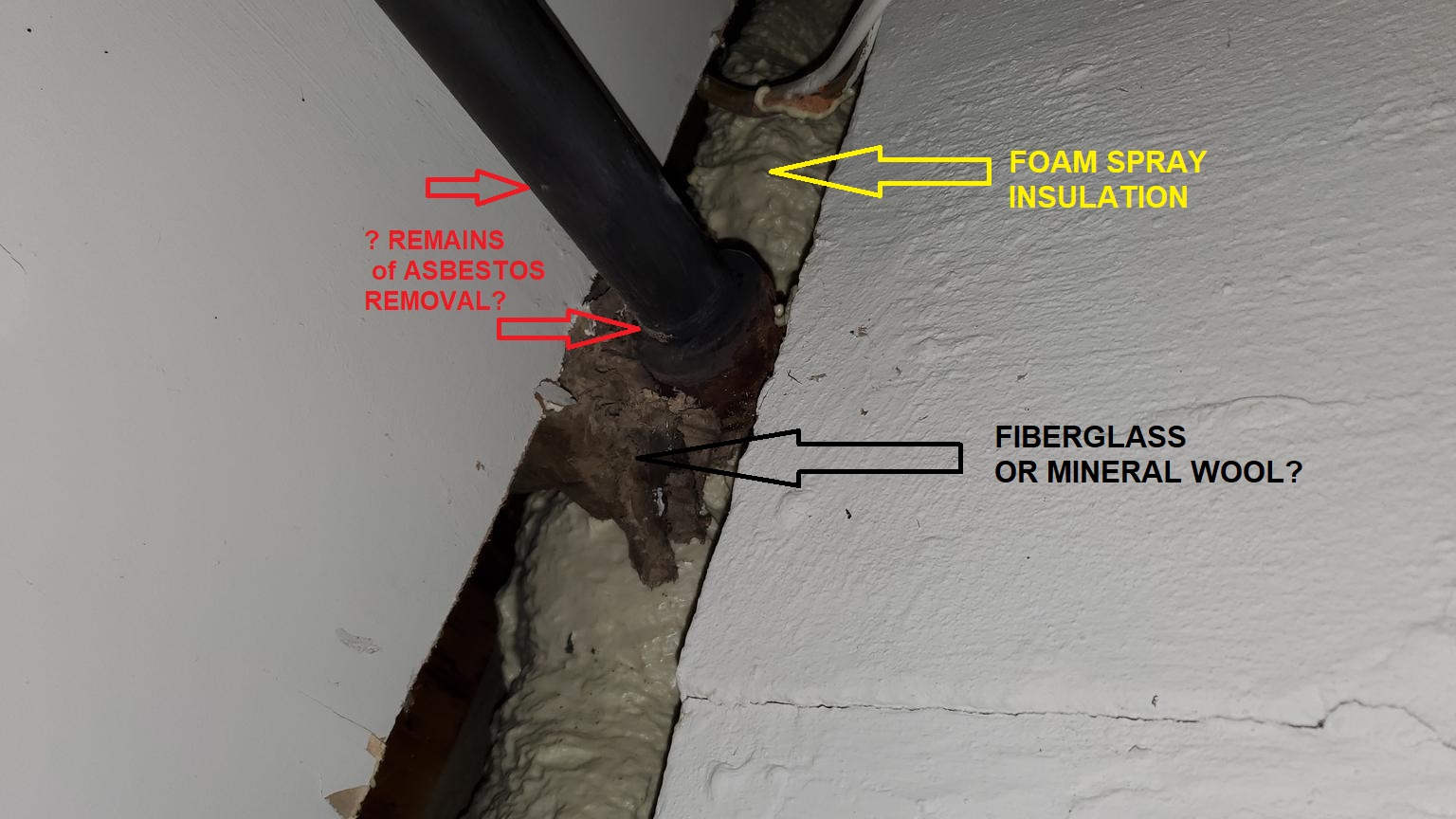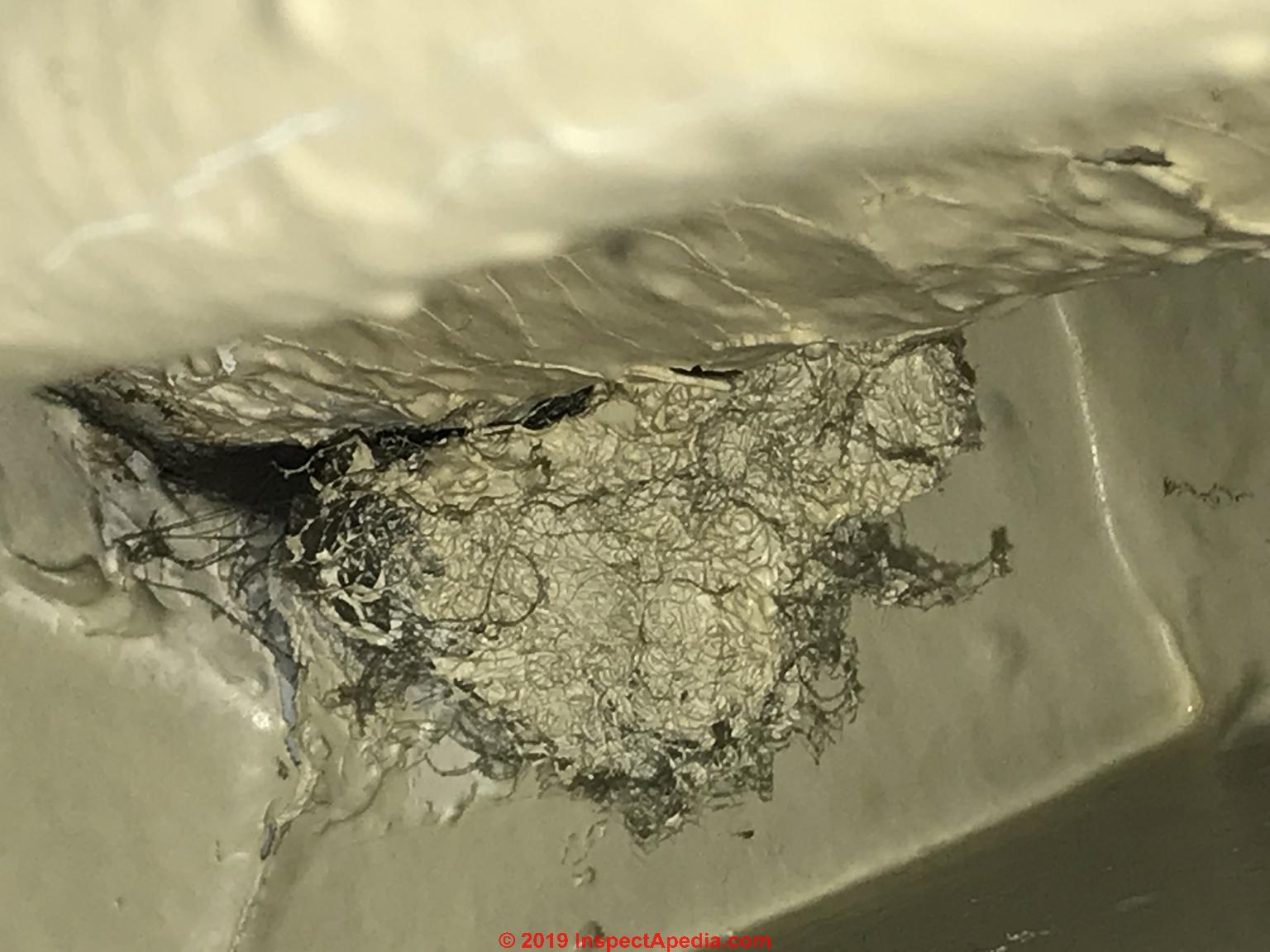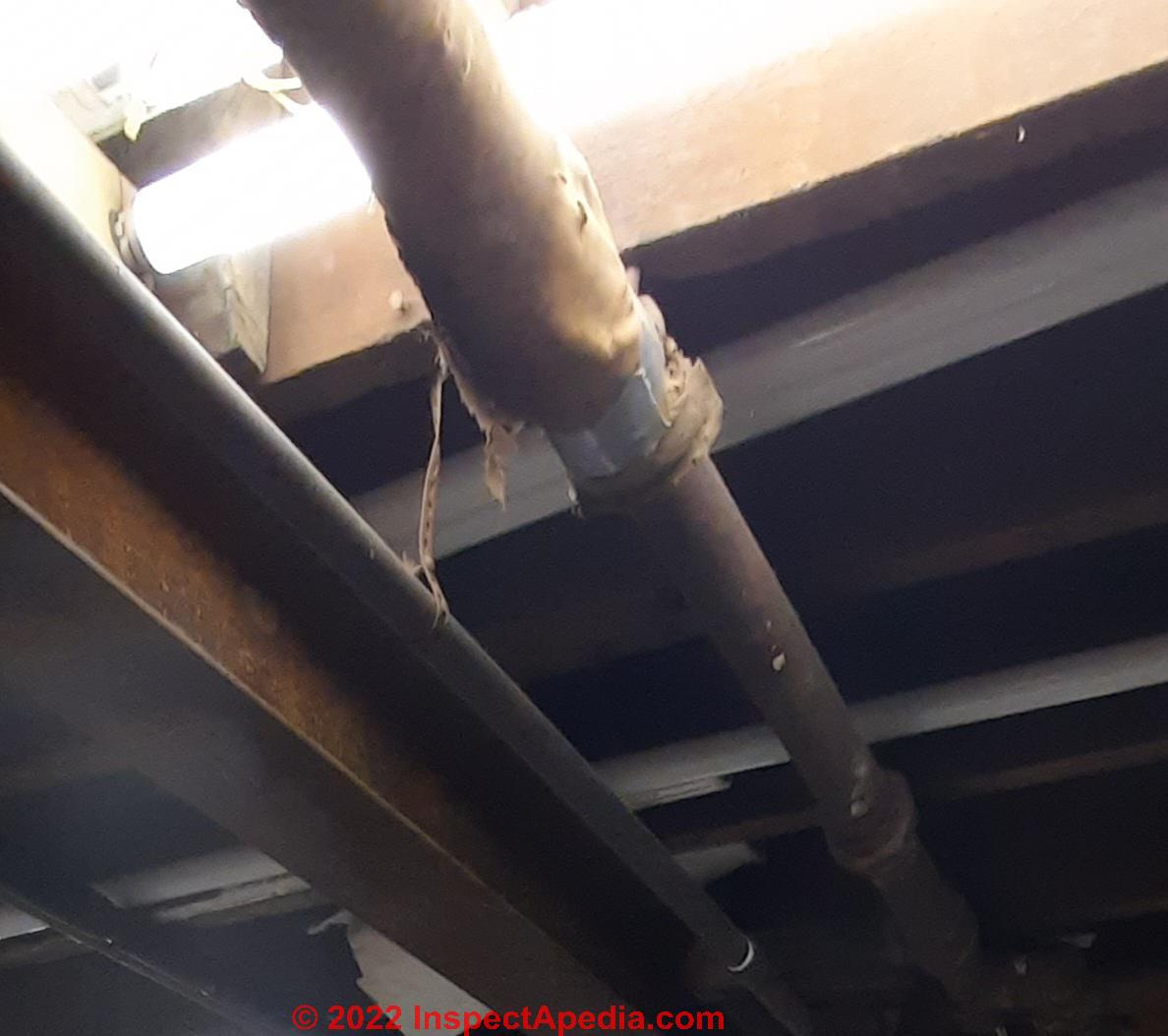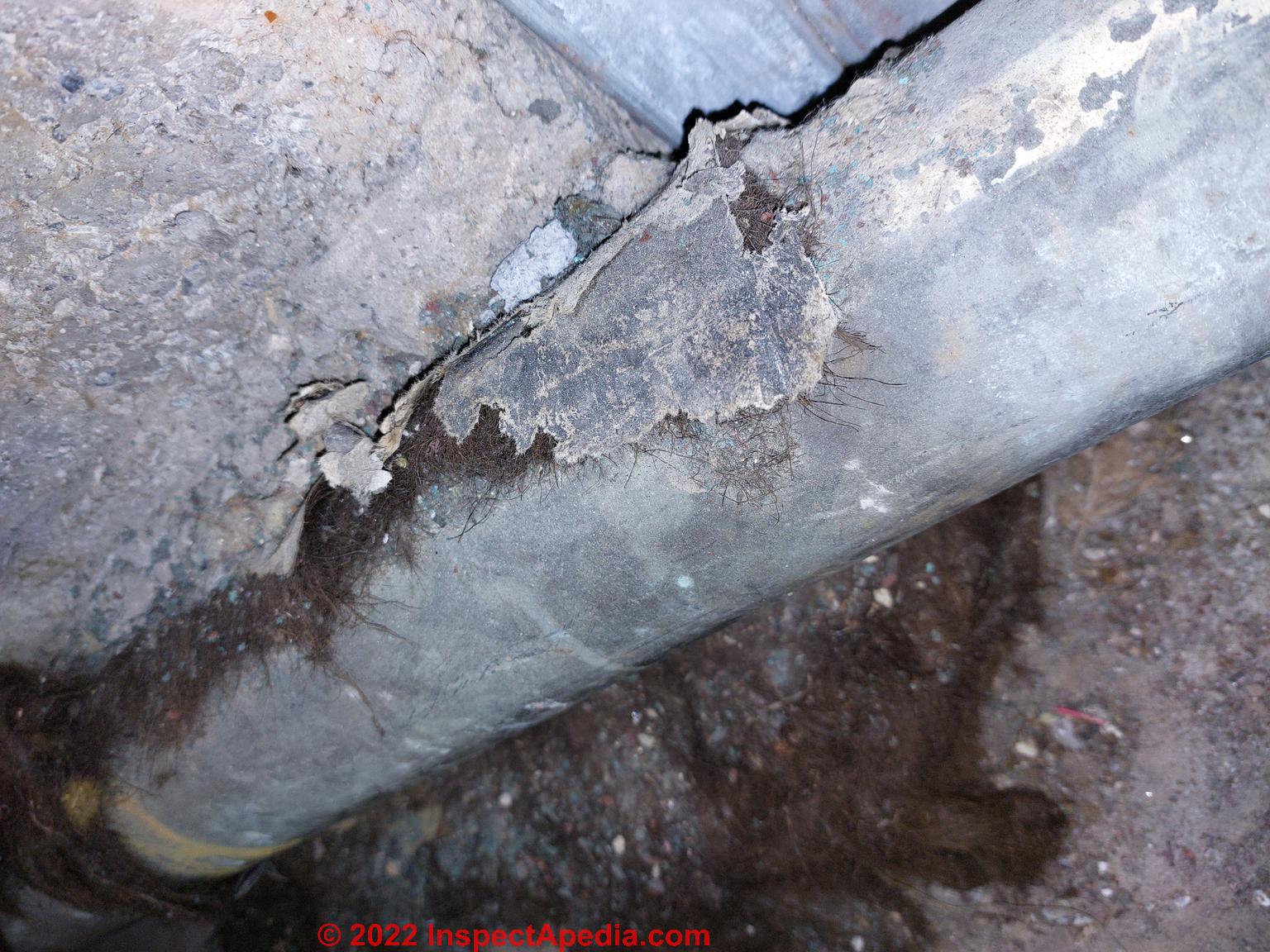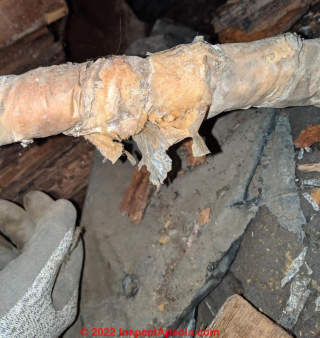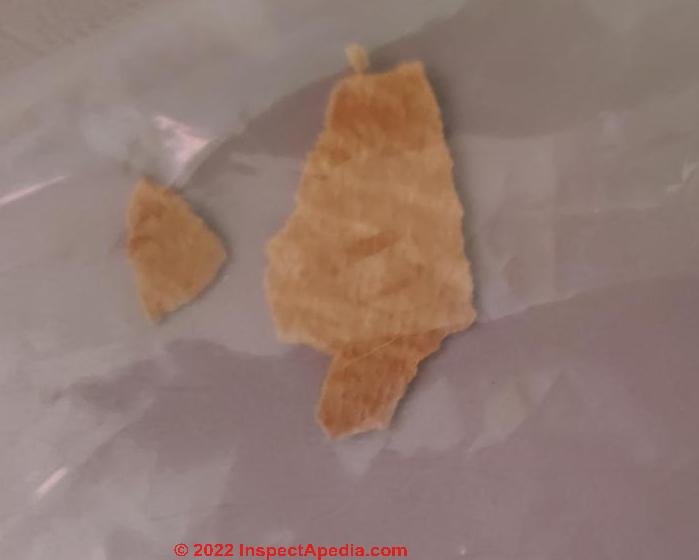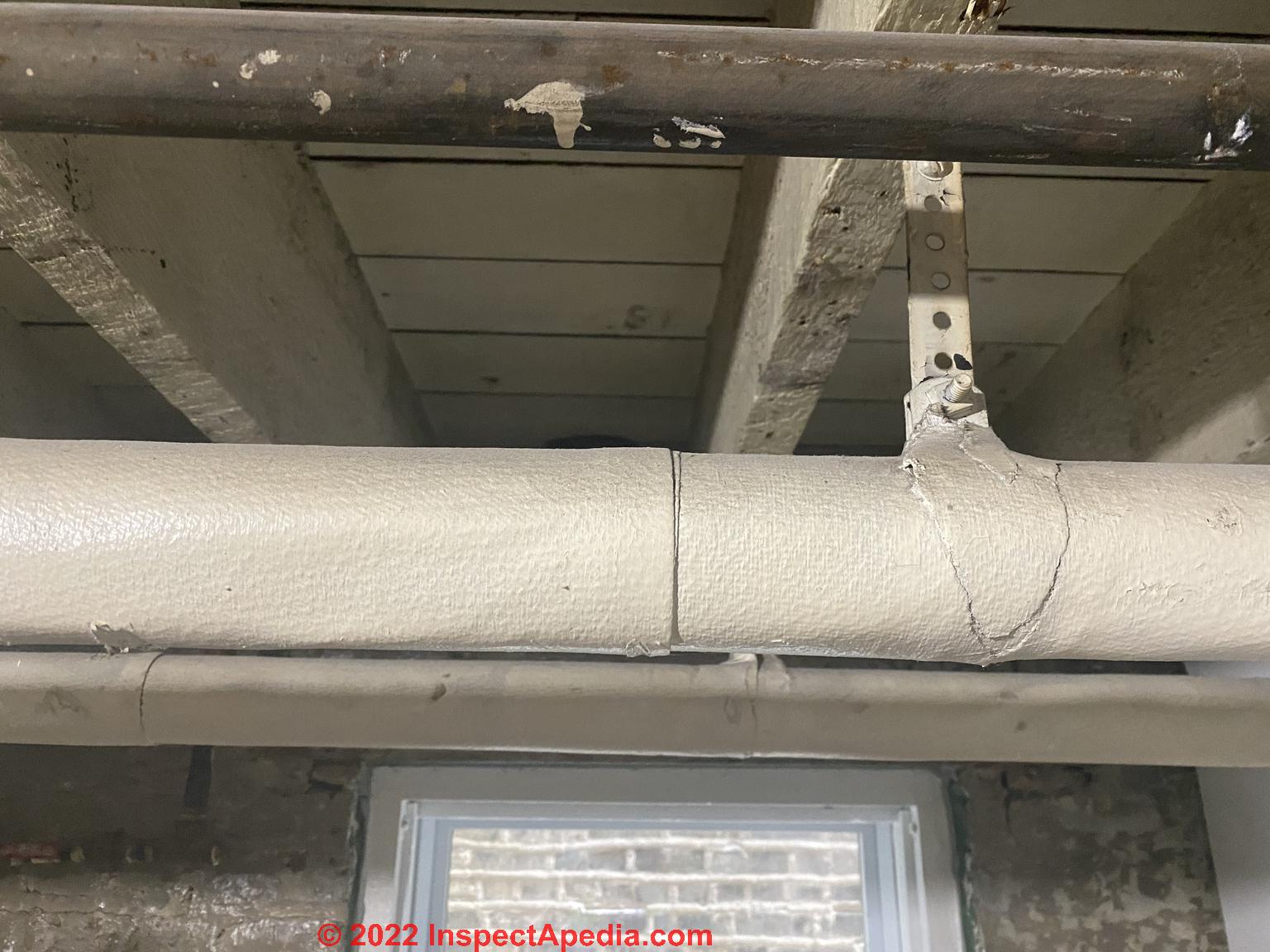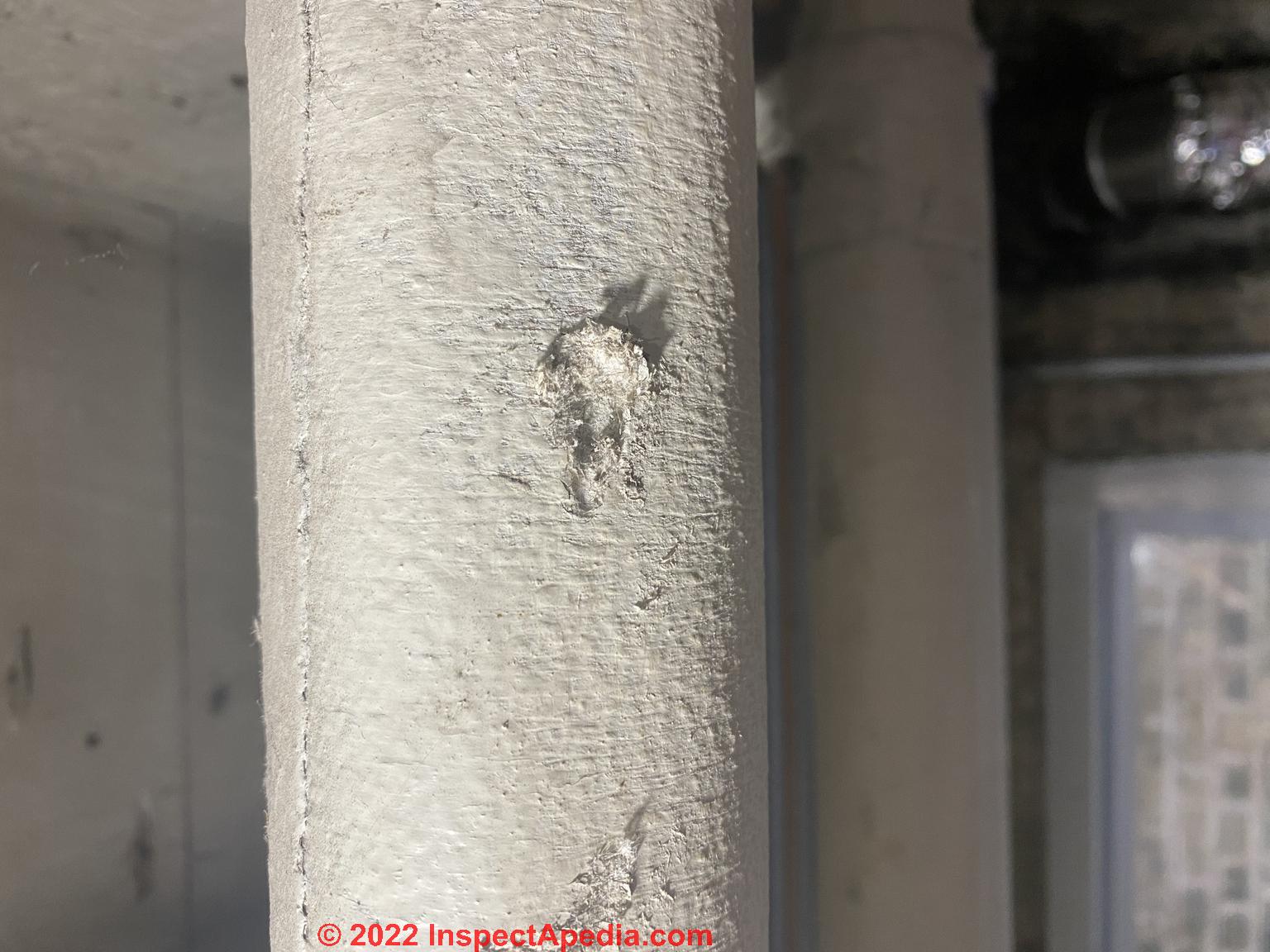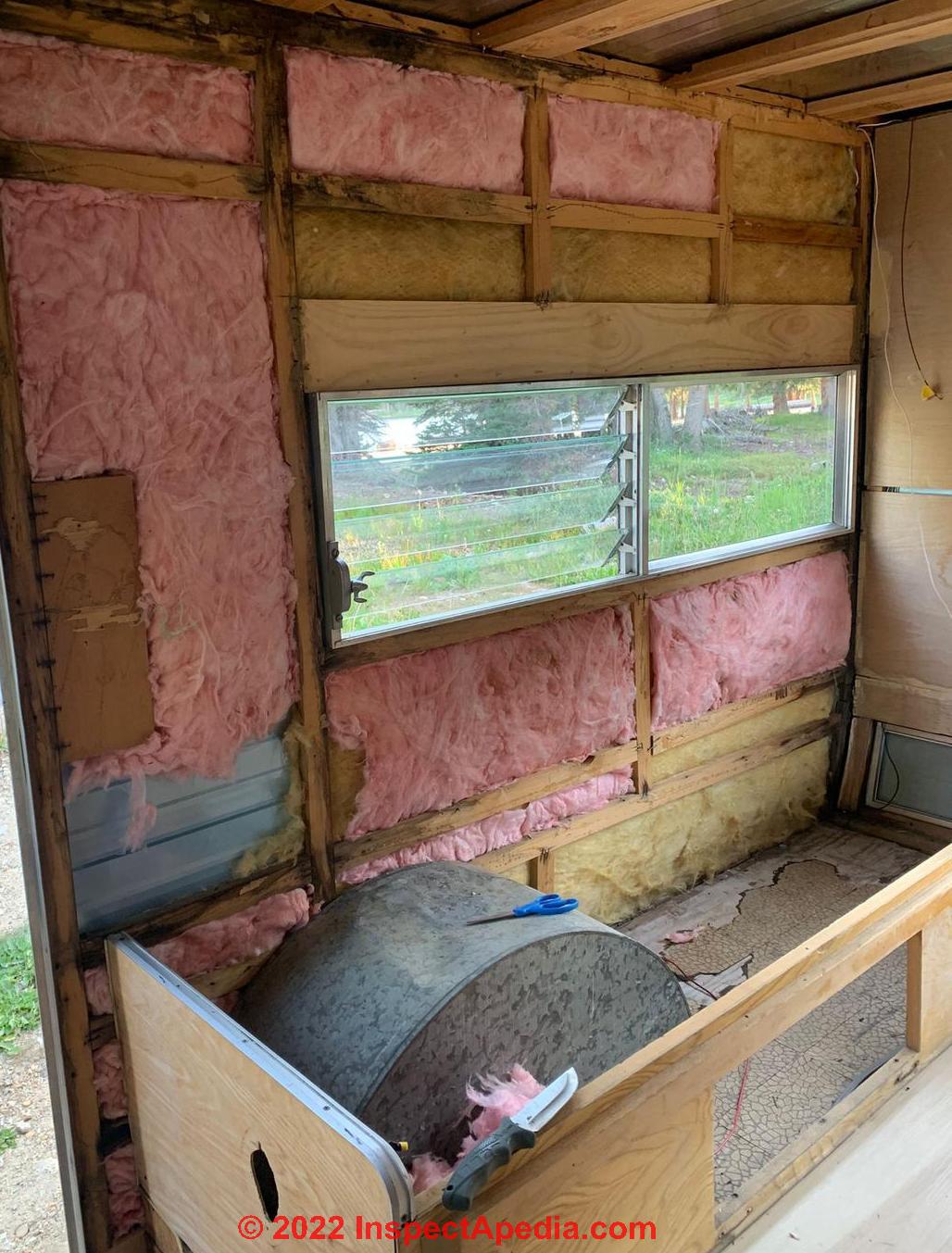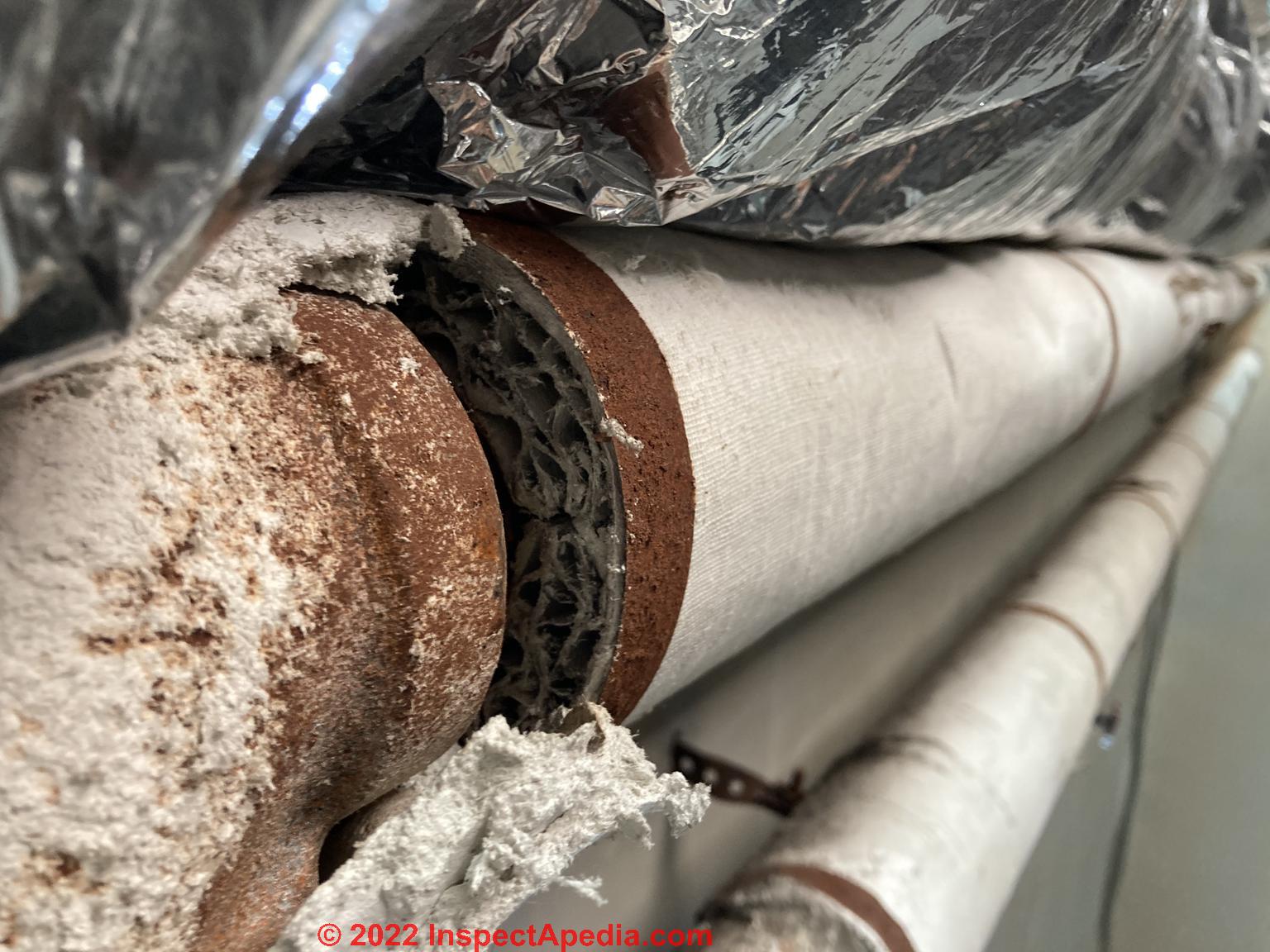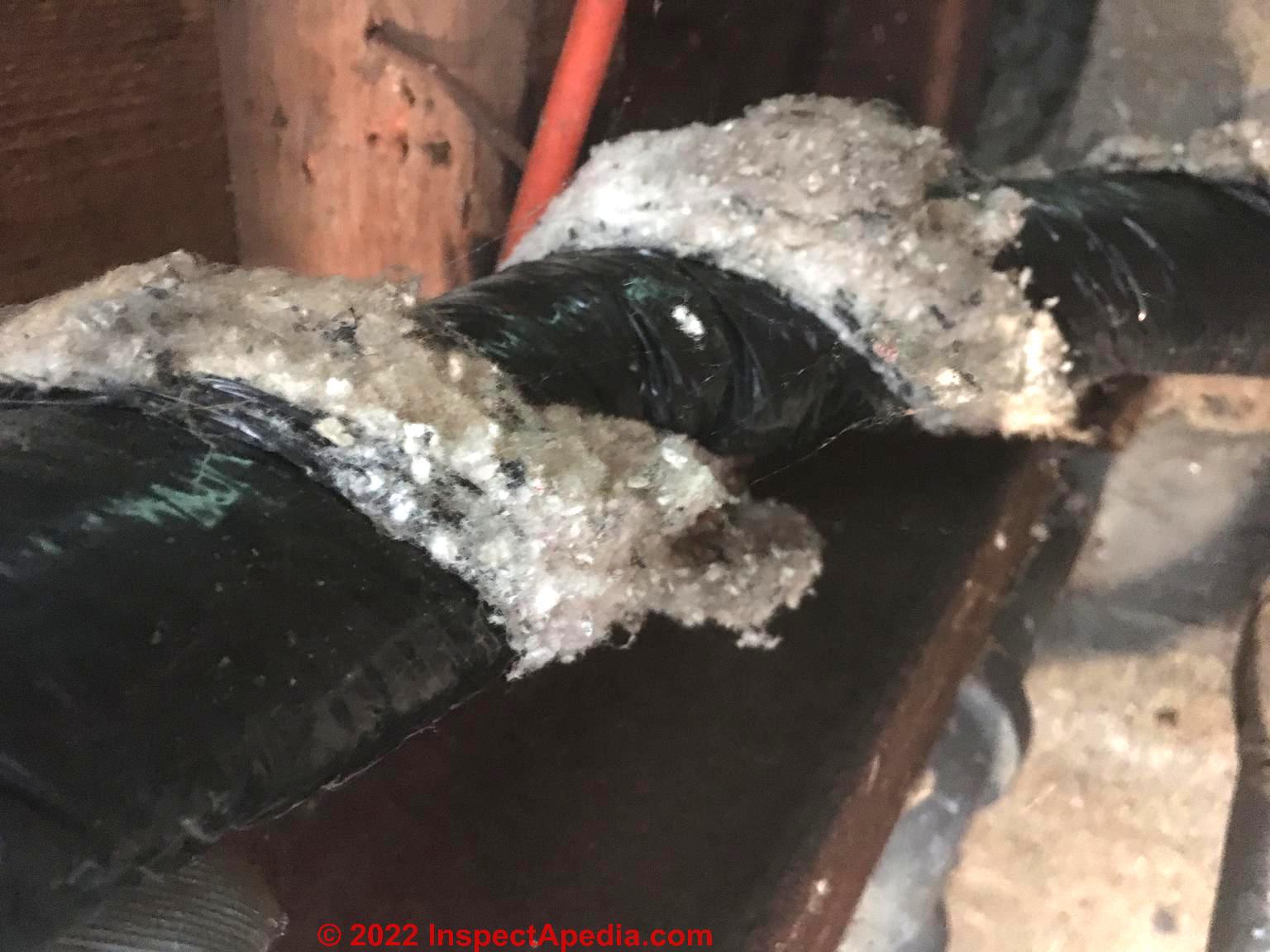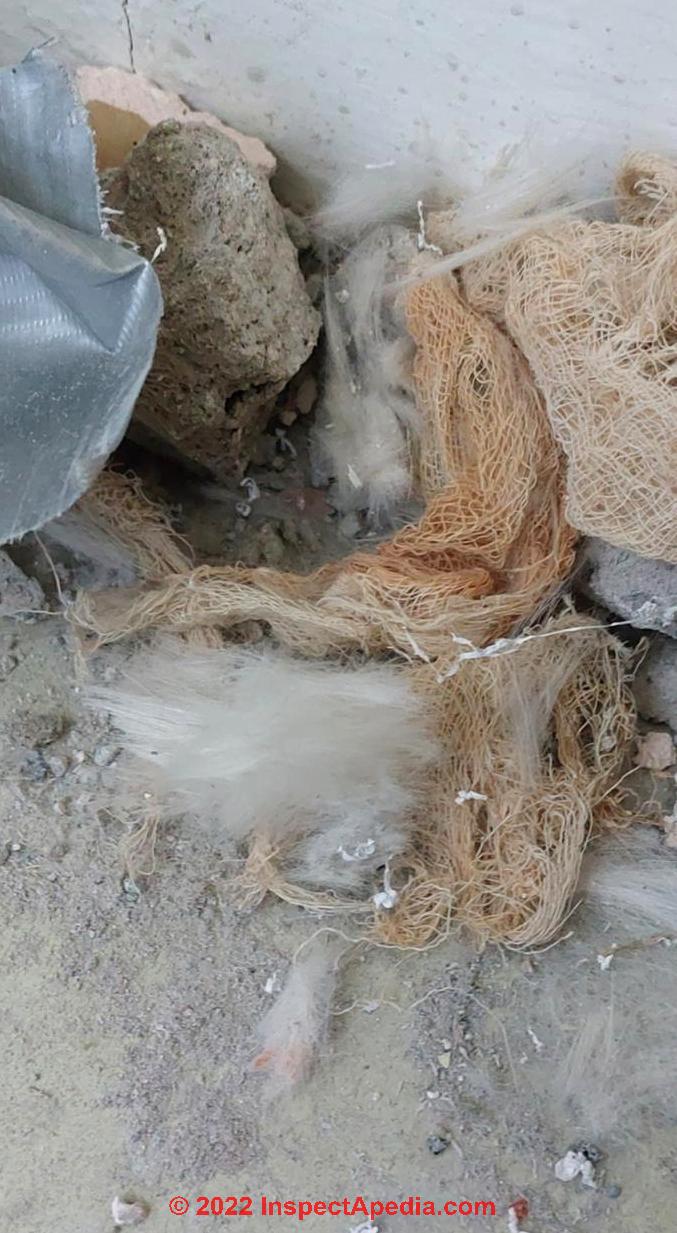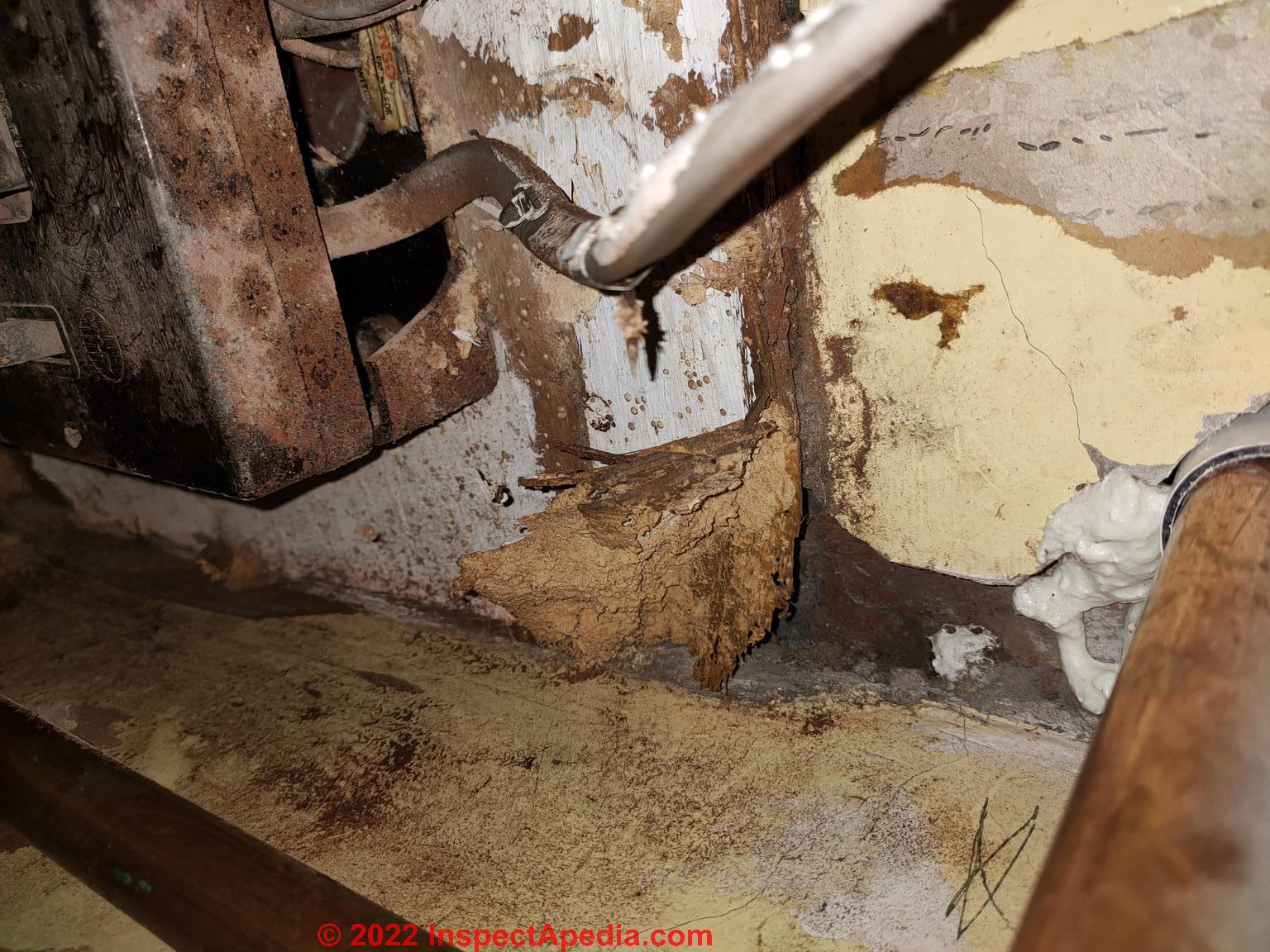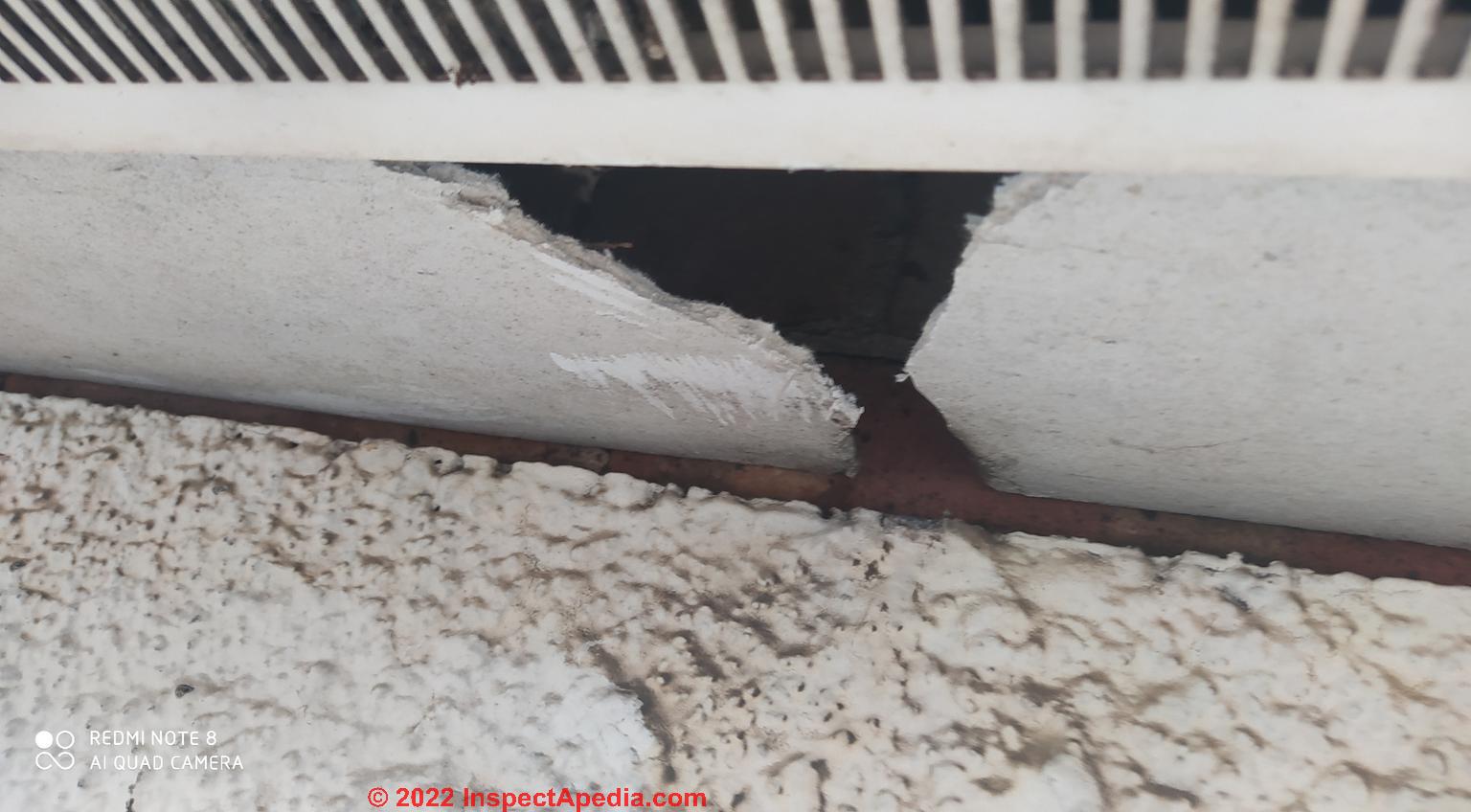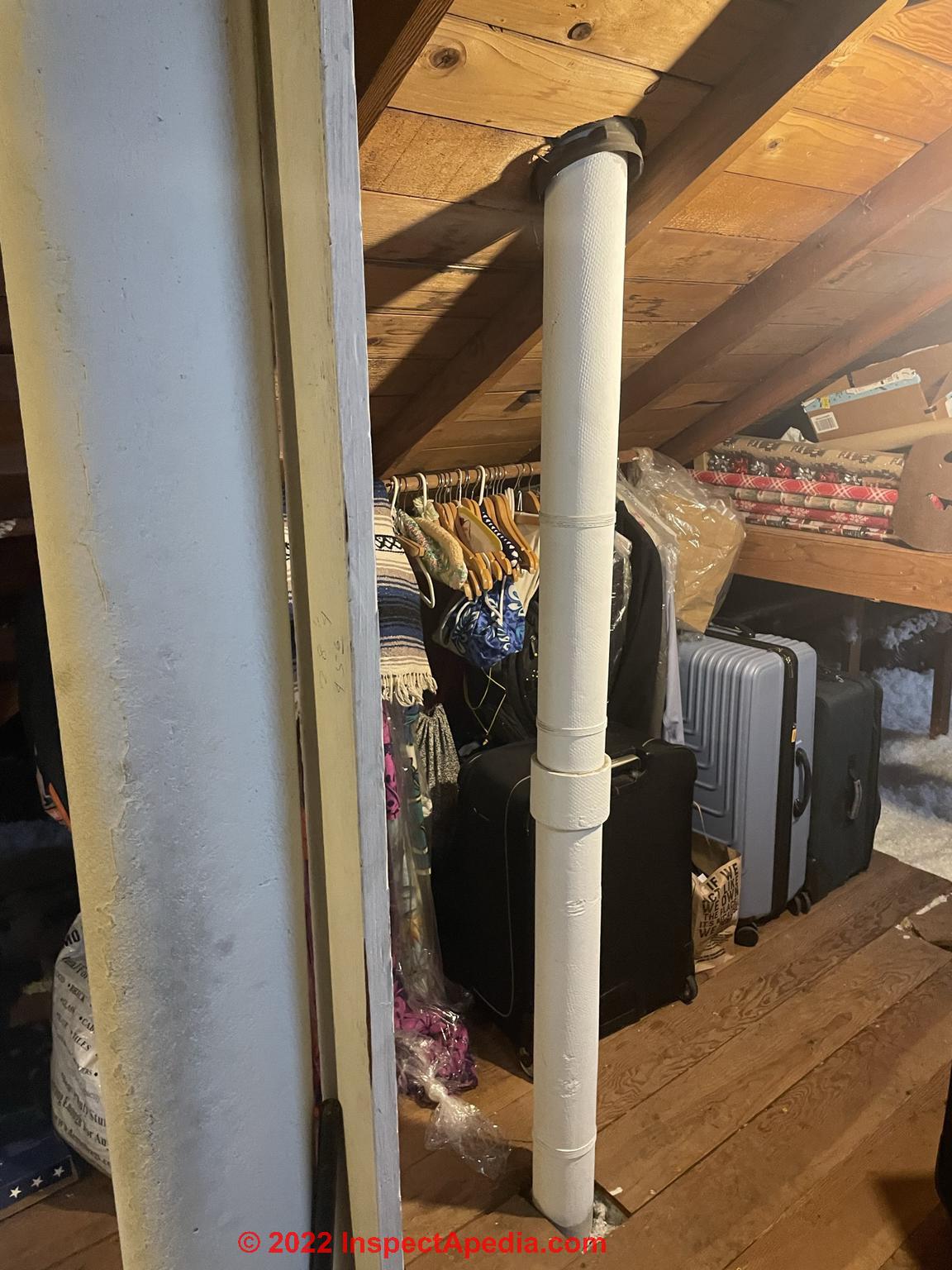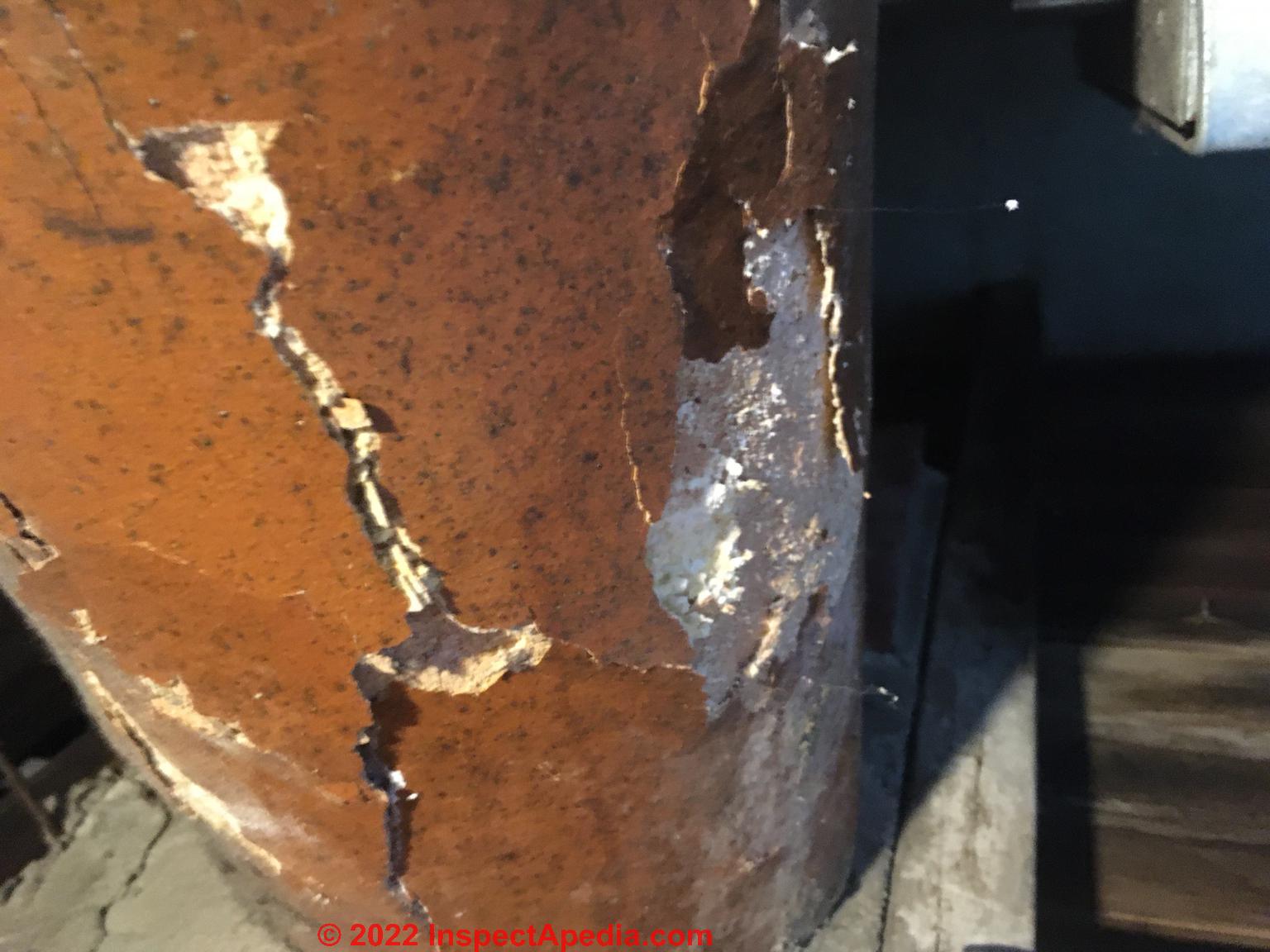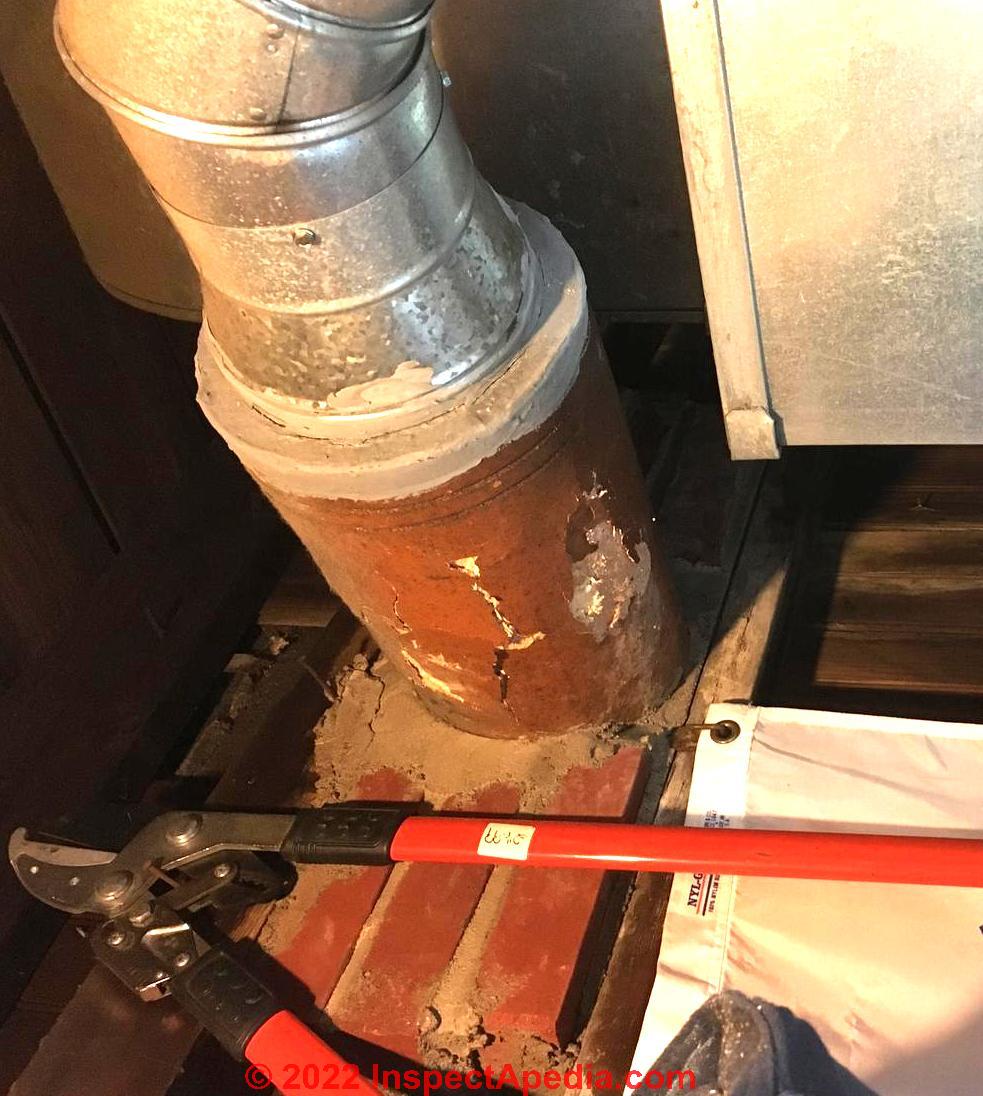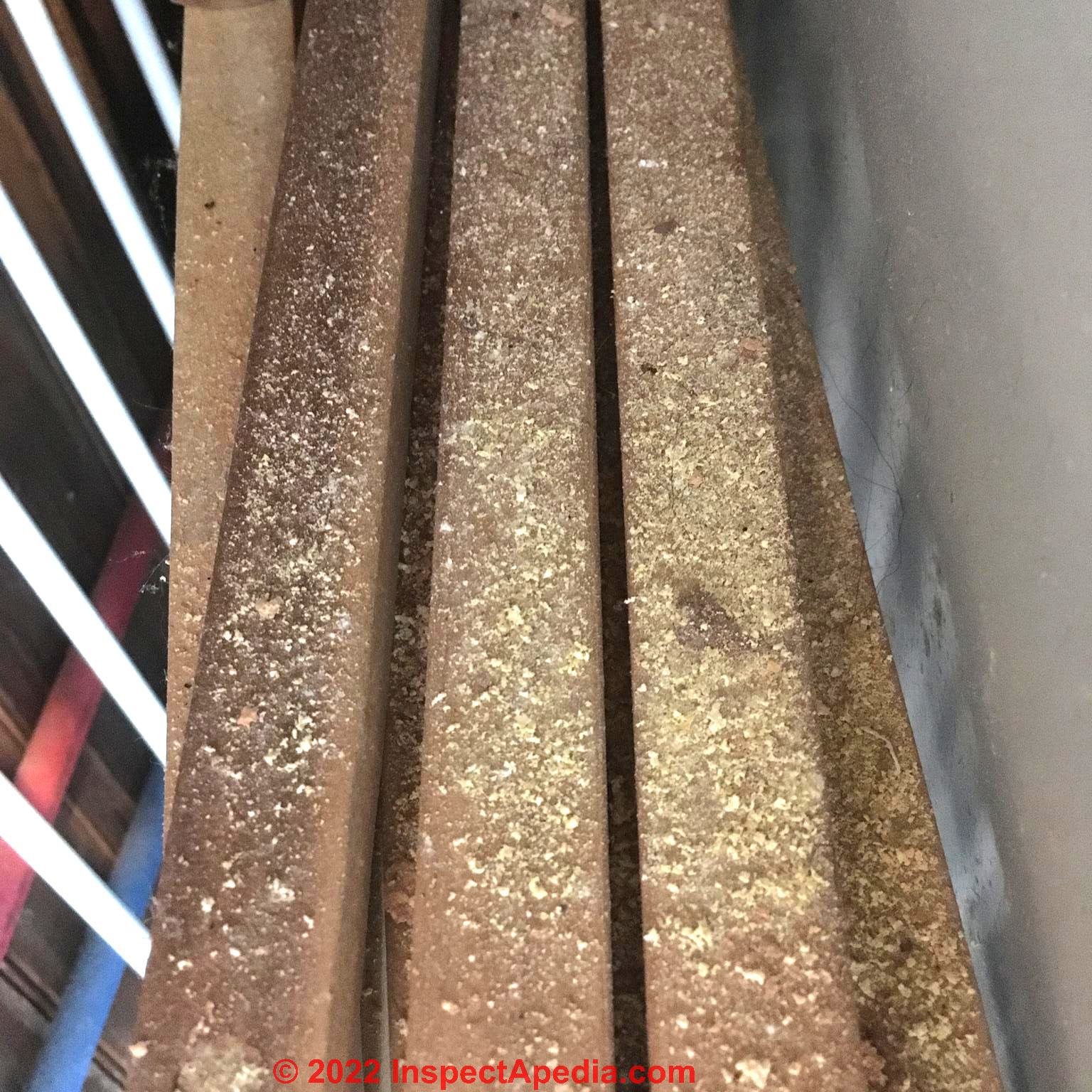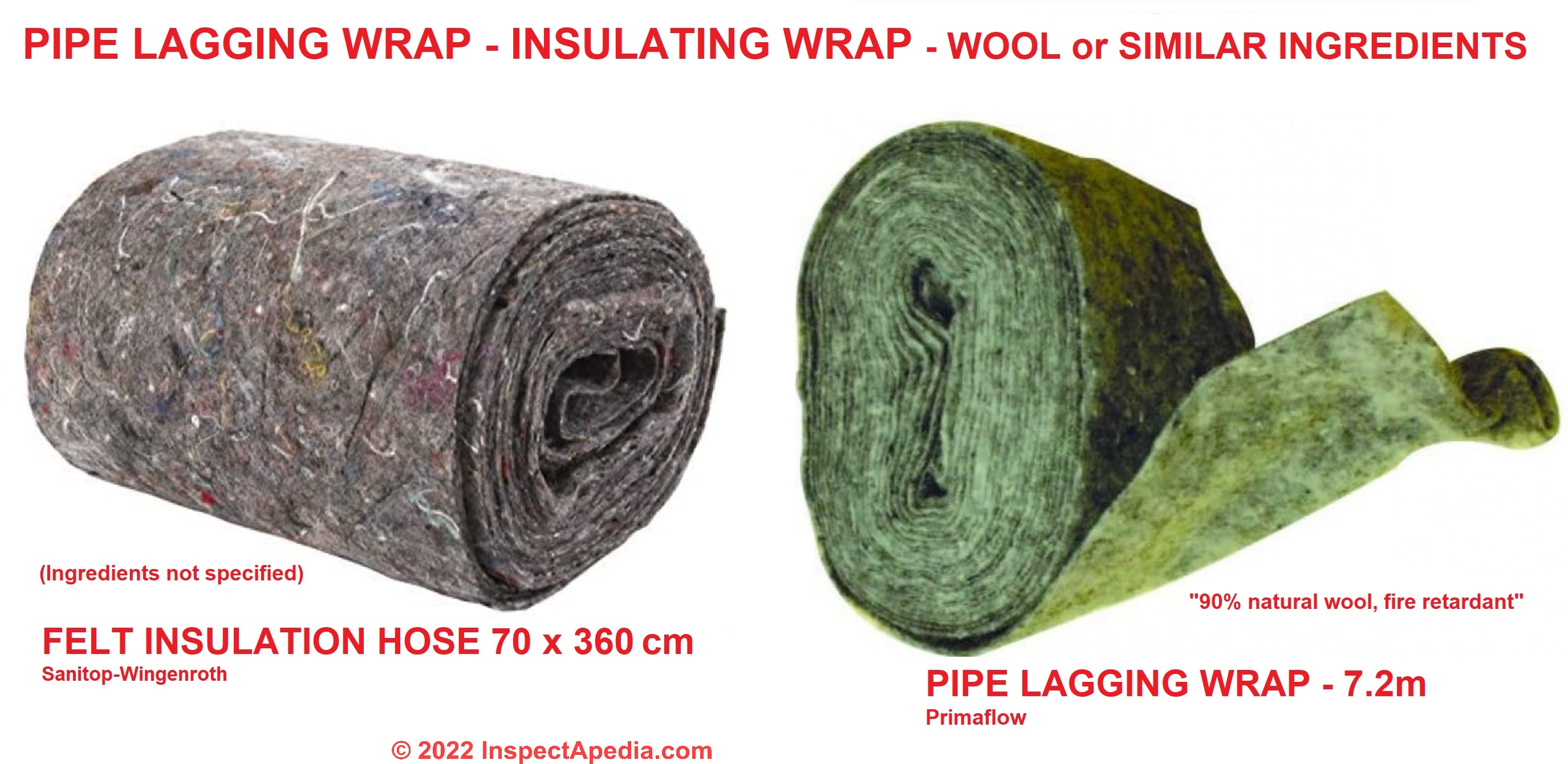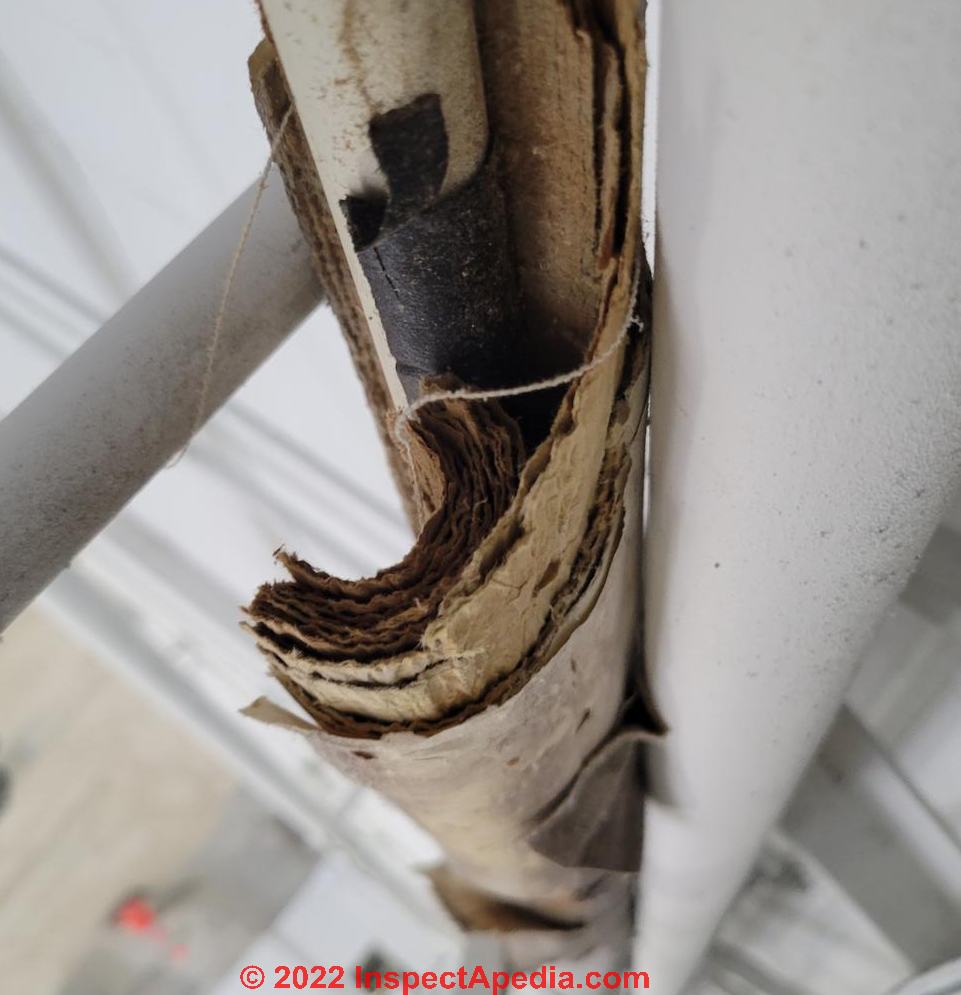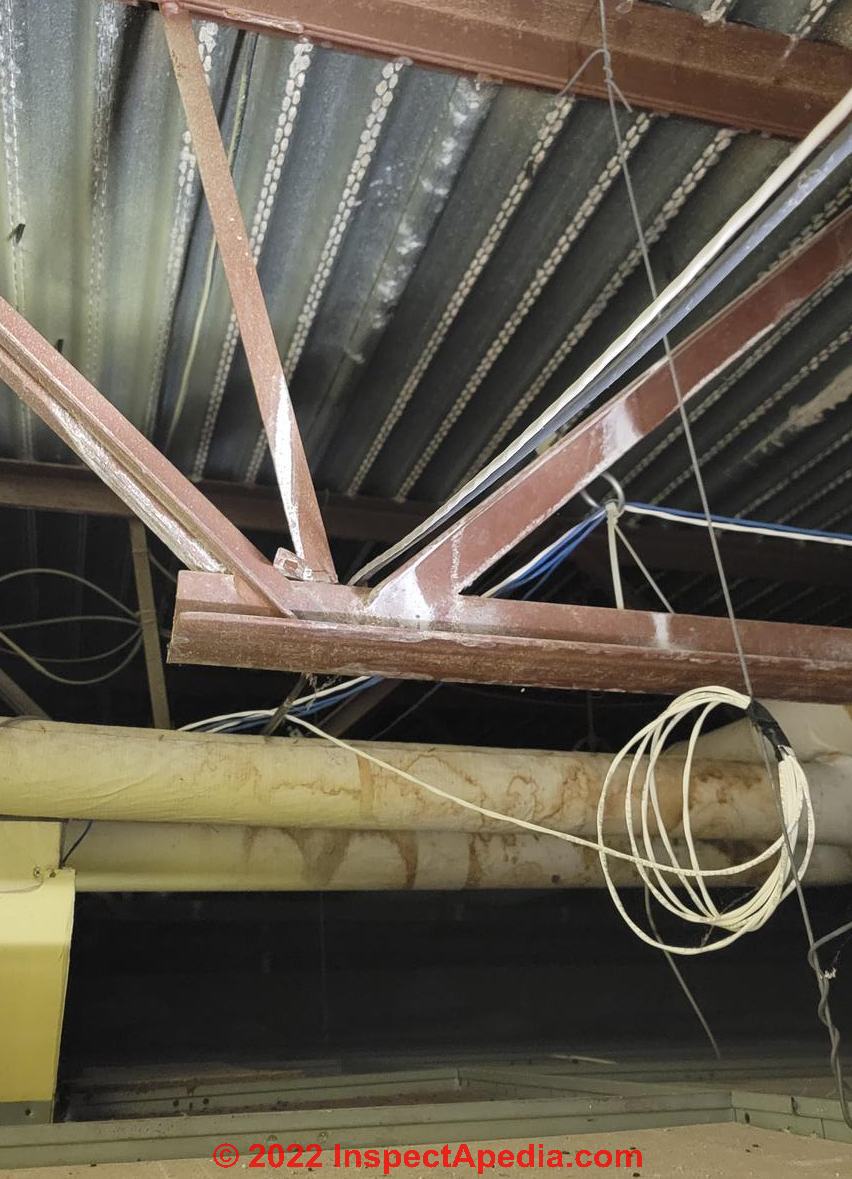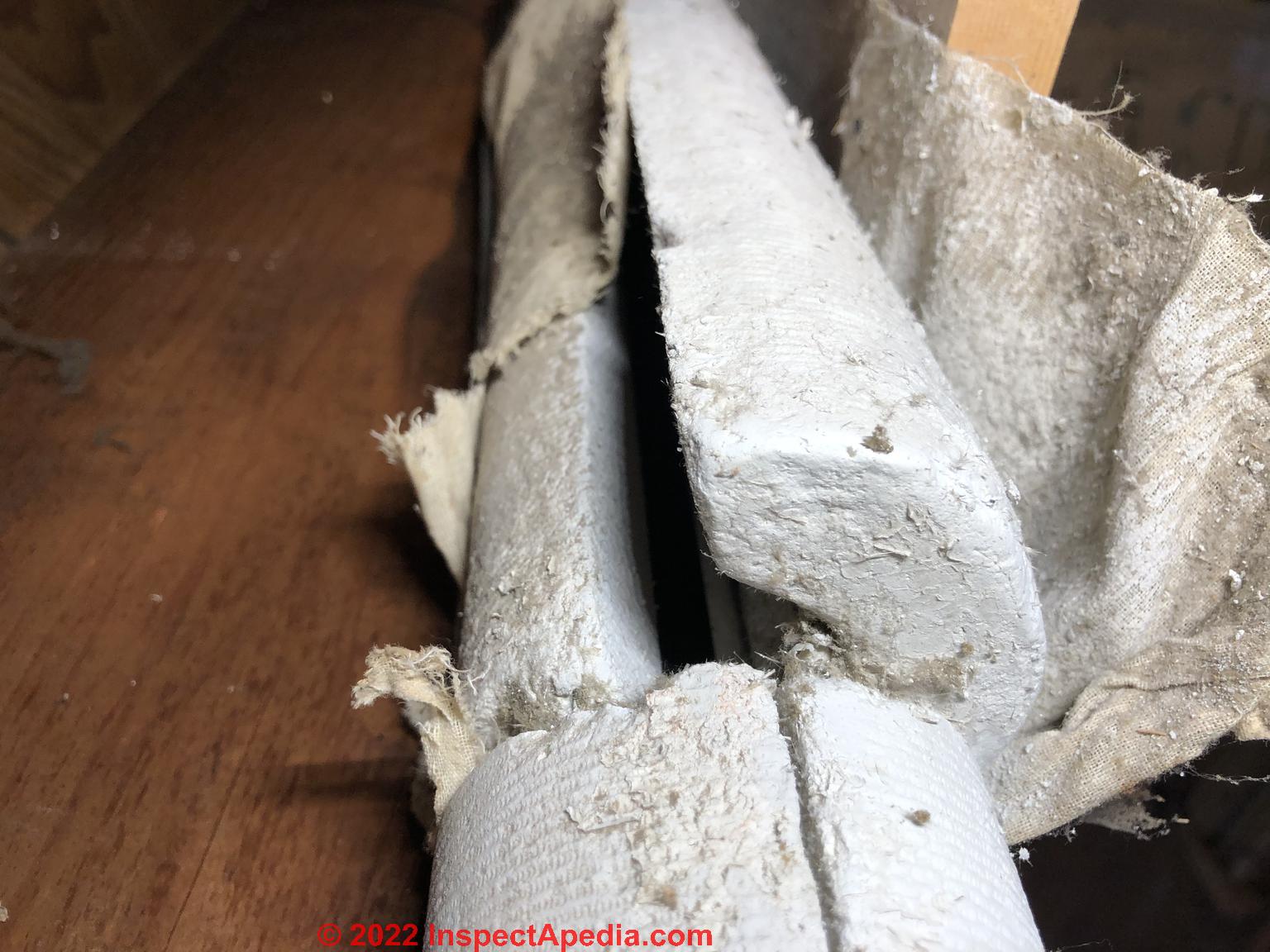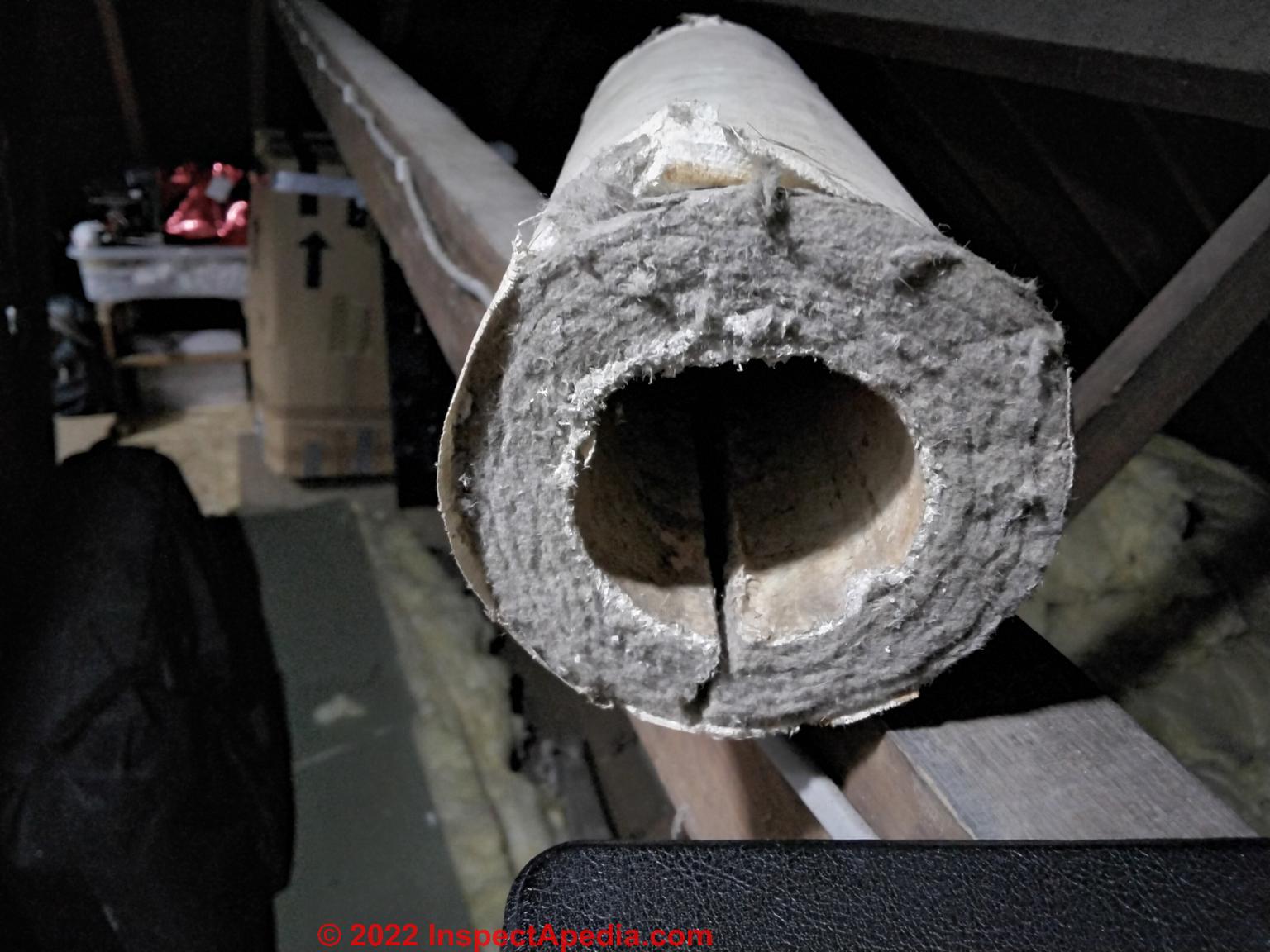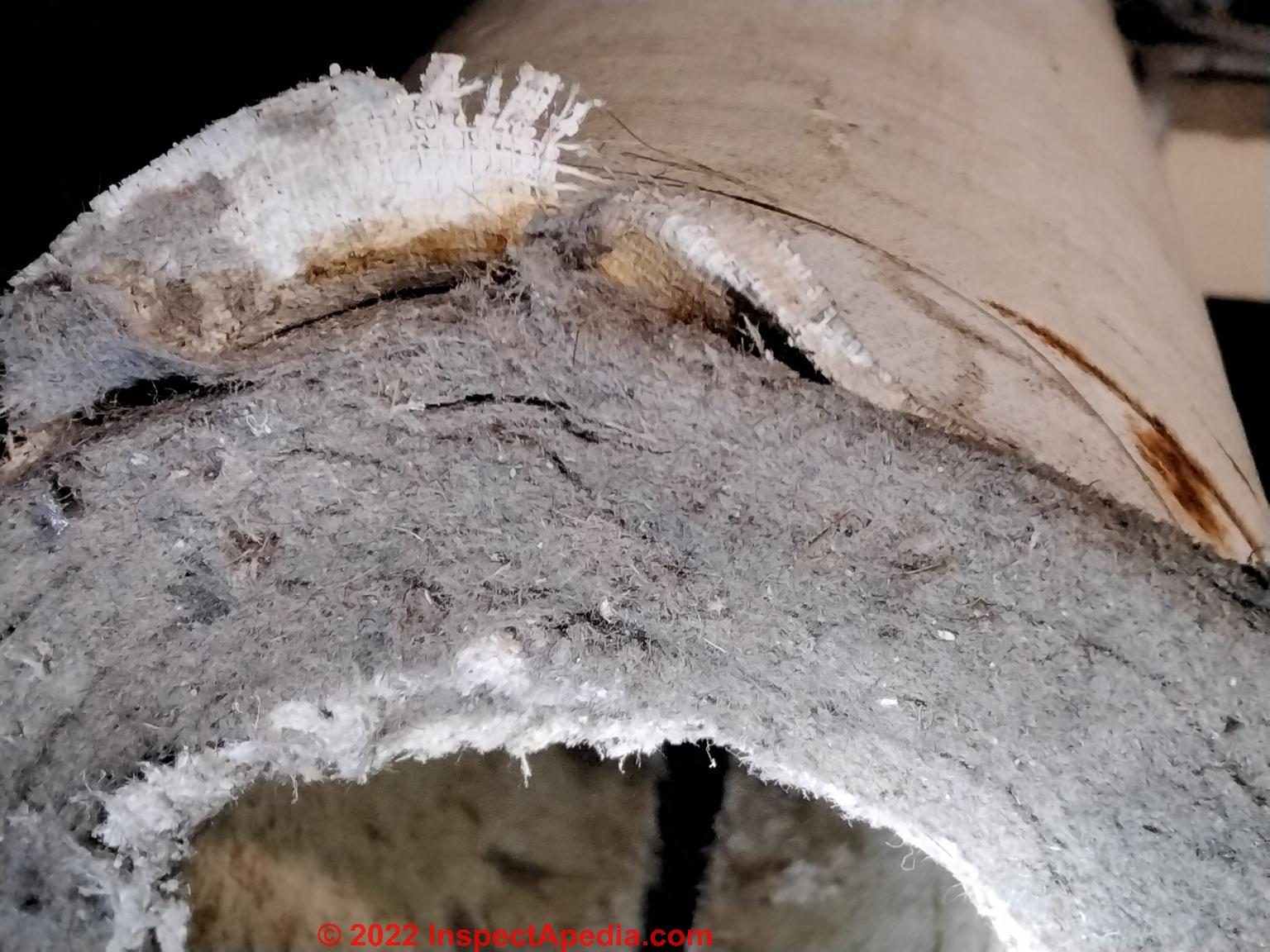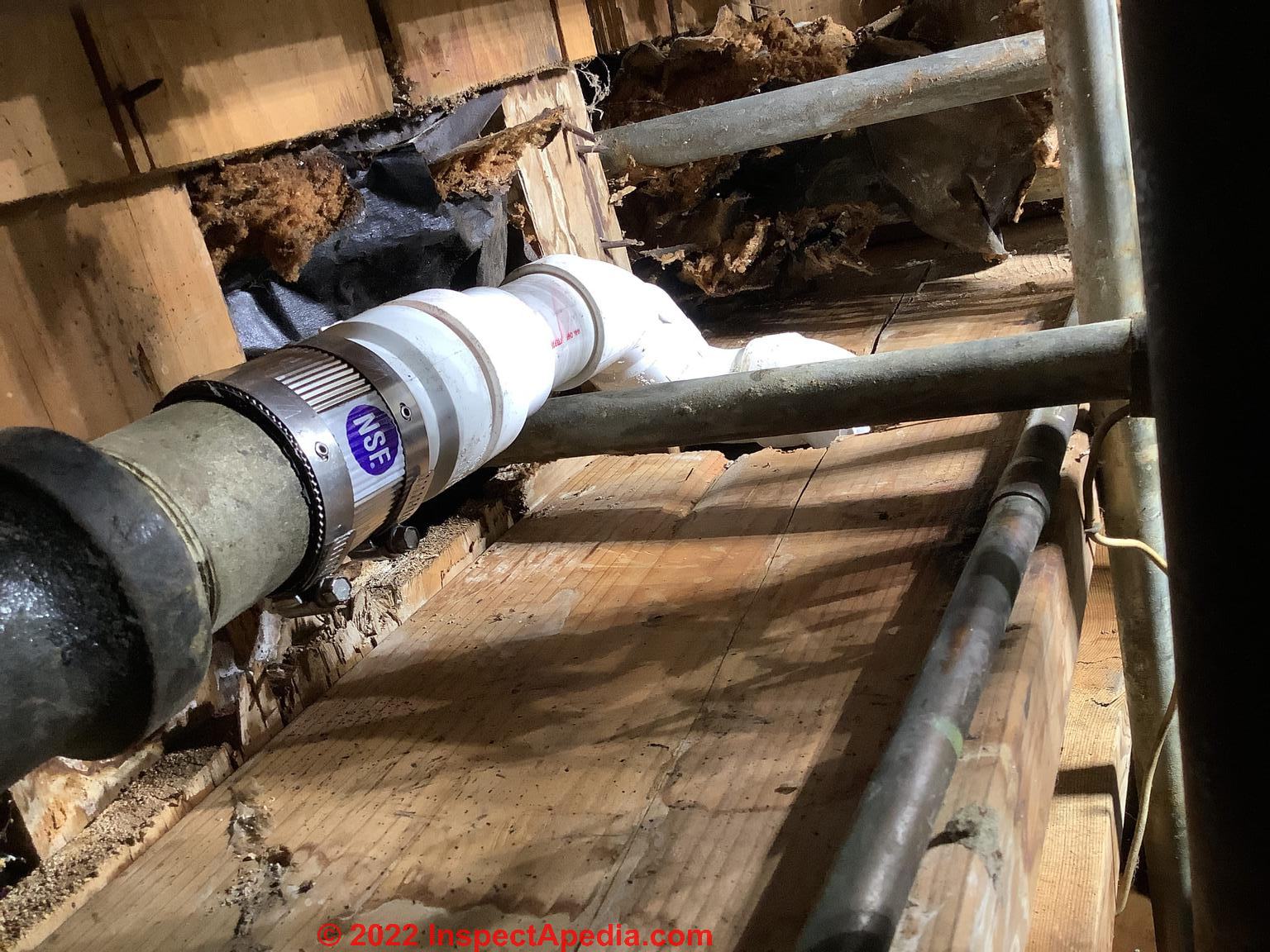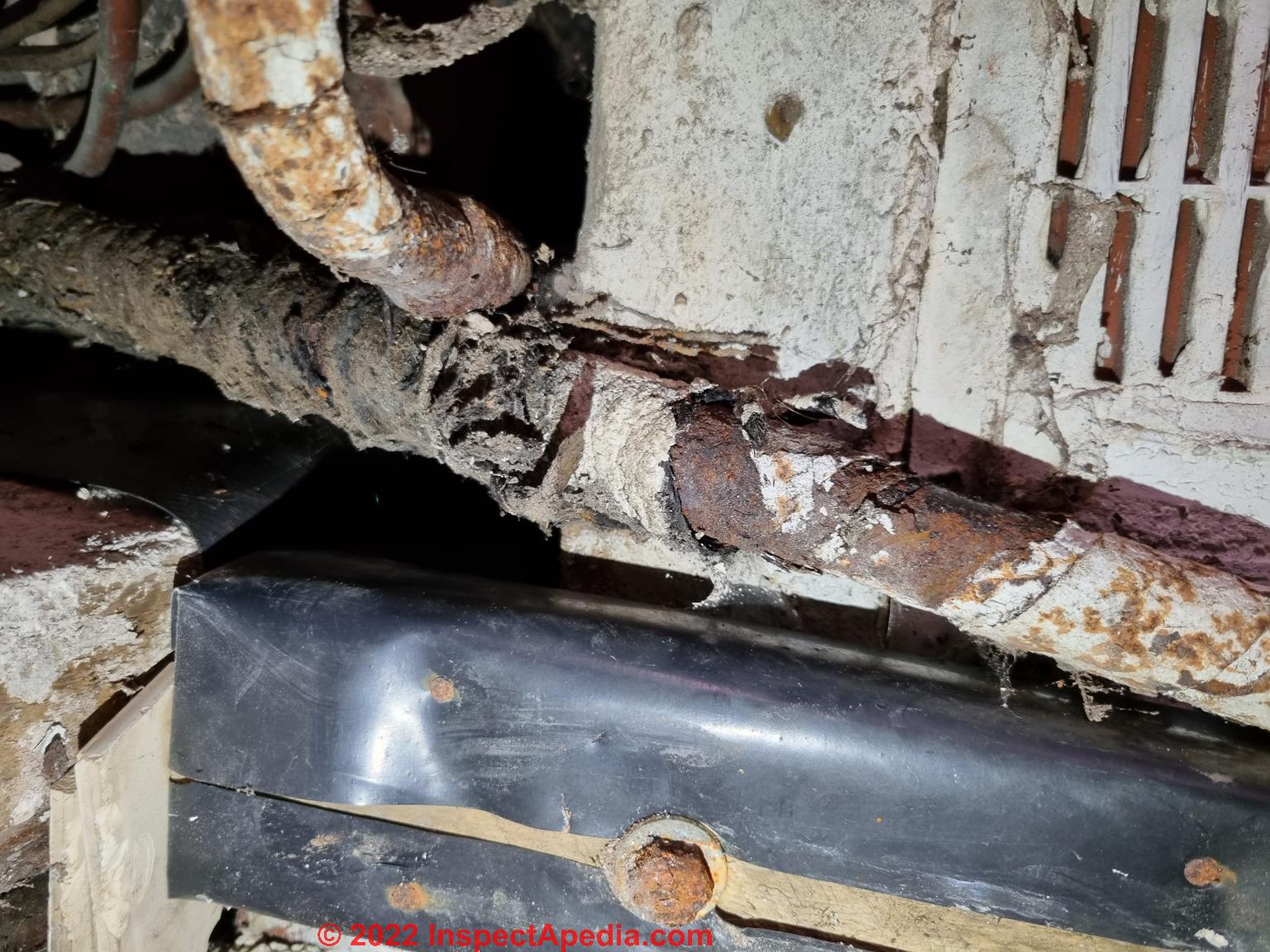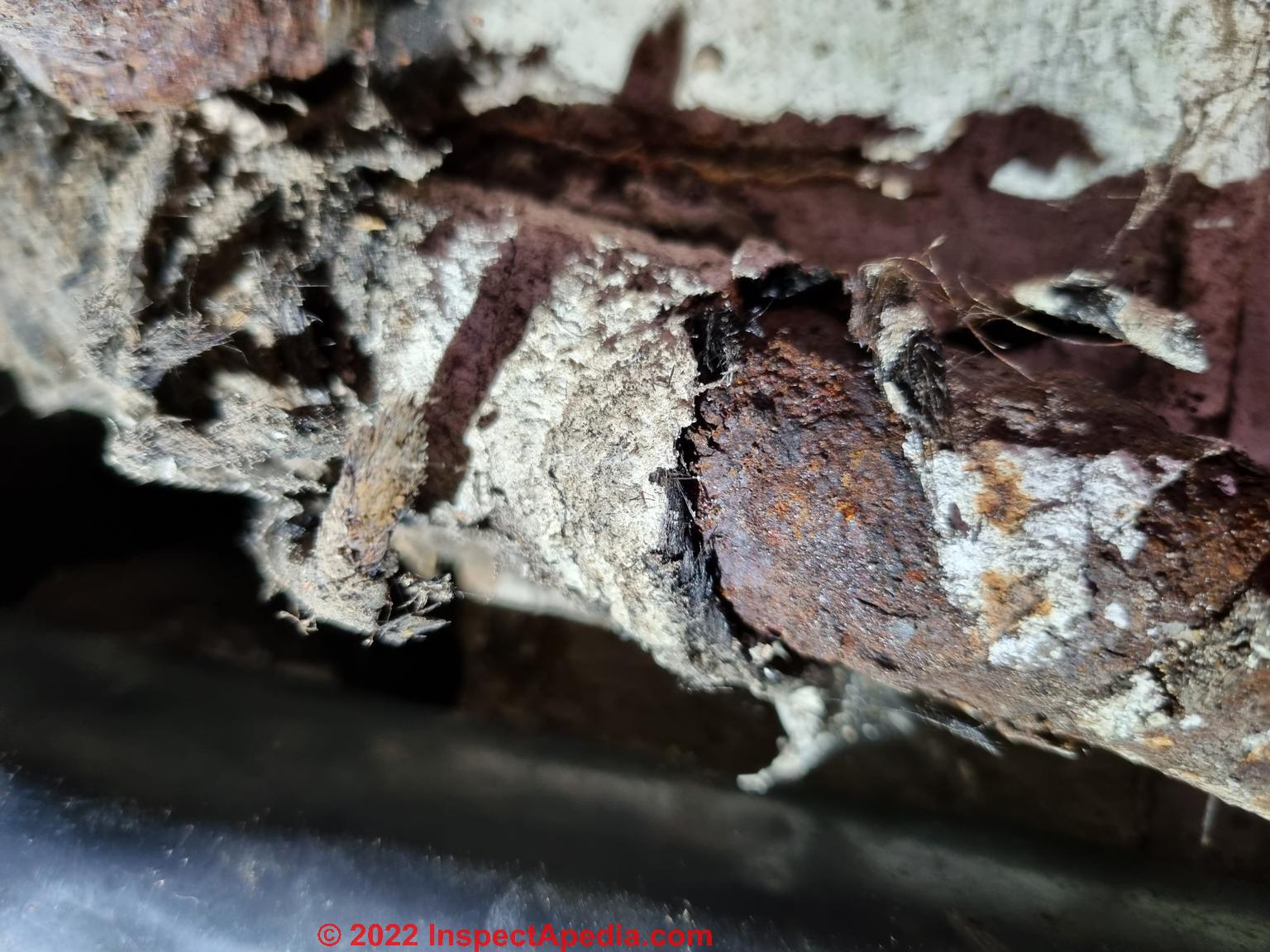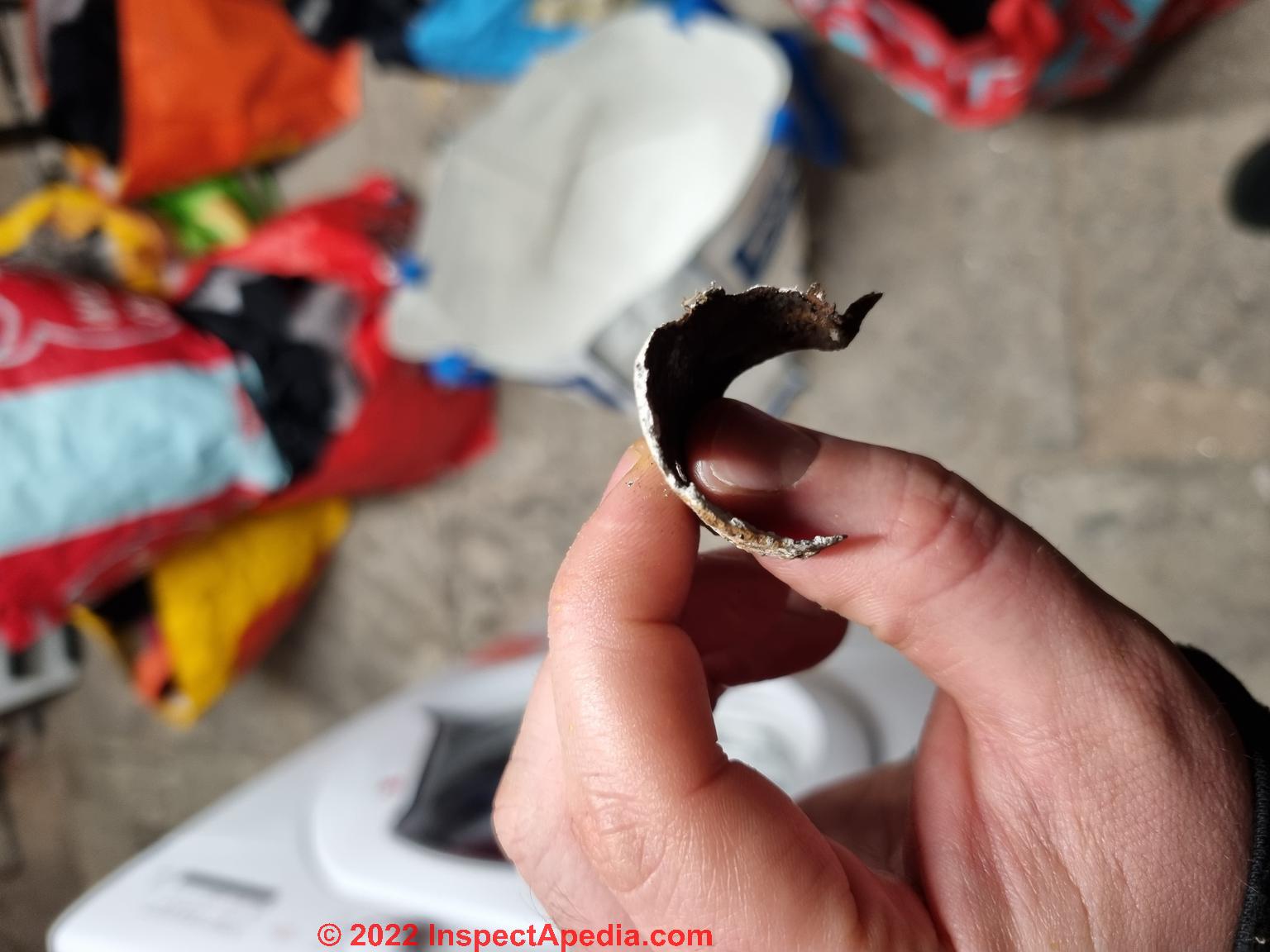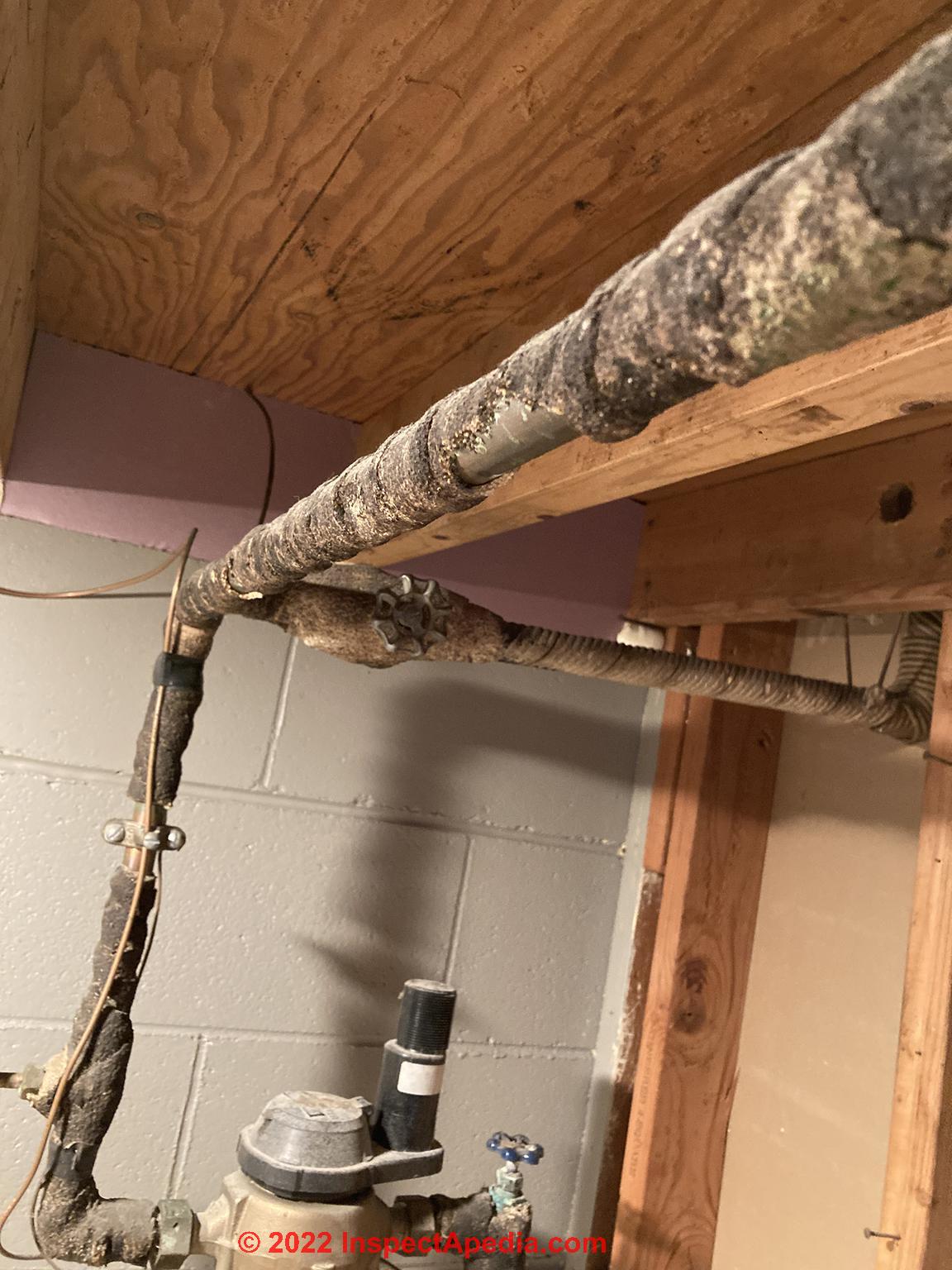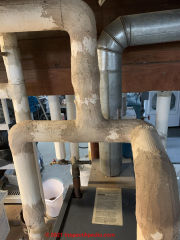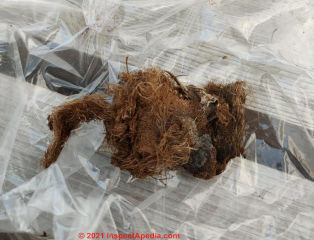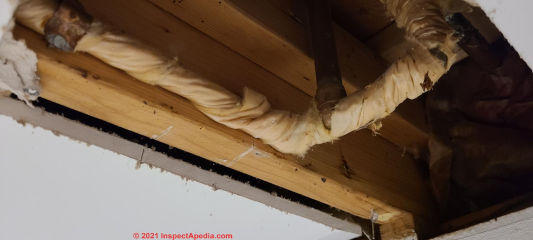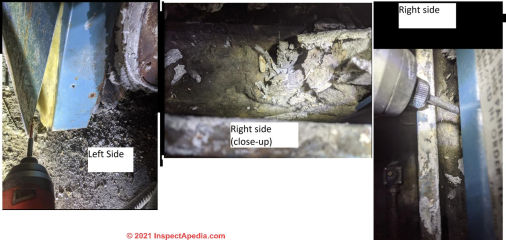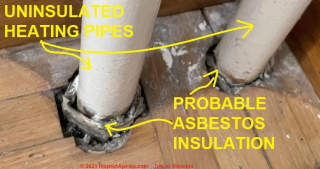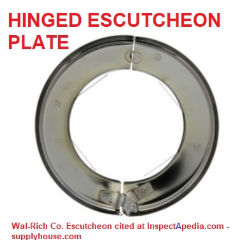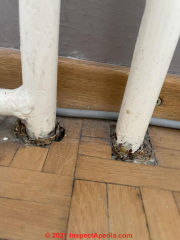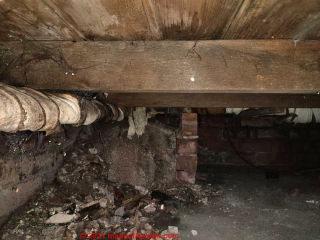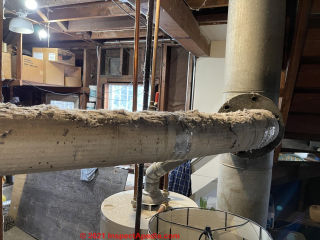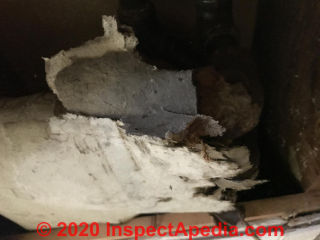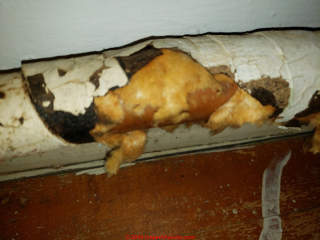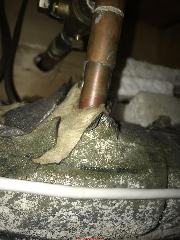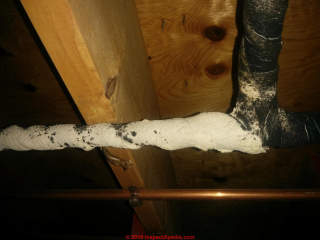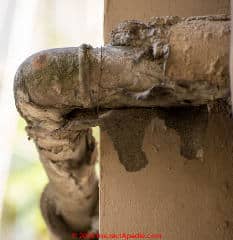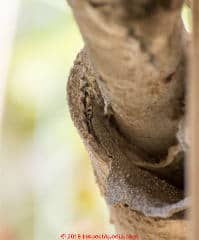 Asbestos Pipe Insulation FAQs
Asbestos Pipe Insulation FAQs
Q&A on asbestos insulation on pipes: identification & action
Examples of pipe insulation that is or contains asbestos
Examples of pipe insulation that is NOT asbestos
- POST a QUESTION or COMMENT about asbestos-containing pipe insulation: identification, encapsulation, or removal
Q&A about asbestos pipe insulation in buildings:
Questions and answers about how to recognize asbestos insulation on heating or water pipes and what to do about it.
This article series provides photographs of abandoned and partly-covered-up asbestos pipe insulation in buildings to assist in the recognition of that material.
Page top photo: Asbestos found at the inner core of gray felt-like pipe wrap on a building in the U.K. courtesy of reader Steve and discussed in detail on this page at "Identify this gray pipe insulation used in Hertfordshire in a 1938 building".
InspectAPedia tolerates no conflicts of interest. We have no relationship with advertisers, products, or services discussed at this website.
- Daniel Friedman, Publisher/Editor/Author - See WHO ARE WE?
Asbestos pipe insulation in buildings
 These questions & answers or comments about asbestos-containing pipe insulation and asbestos pipe insulation removal and disposal procedures and costs were posted originally
These questions & answers or comments about asbestos-containing pipe insulation and asbestos pipe insulation removal and disposal procedures and costs were posted originally
at ASBESTOS PIPE INSULATION - be sure to read that article.
Watch out: asbestos pipe inslulation in good condition is usually best left alone or encapsulated: left alone, in place, undisturbed, risks and costs are minimized.
But if asbestos pipe insulation is in poor condition, shedding, damaged, falling-off, or if it is in a location where it is likely to be damaged, it should be removed and the pipes cleaned and sealed.
For asbestos pipe insulation that is in poor condition, falling off it is beyond encapsulation and needs to be removed by a professional.
This article series assists building buyers, owners or inspectors who need to identify asbestos materials (or probable-asbestos) in buildings by simple visual inspection.
Photo above: clouds of dust and debris high in asbestos used on lower floors of the Twin Towers of New York World Trade Center during the 9/11/2001 World Trade Center attack and disaster in which, combined with the attack on the U.S. Pentagon, nearly 3000 people were killed.
Question: I have about 30' of old hot water radiator heat piping with asbestos insulation ... what is the best method for removal ..
I have about 30' of old hot water radiator heat piping with asbestos insulation like that shown at the top of ASBESTOS PIPE INSULATION
Need to remove insulation and then piping. Insulation appears to be wrapped in a cloth wrapping (more asbestos?).
Is the insulation very friable? Besides using all proper PPE, isolation and clean-up described in your other sections, what is best method for removal of this asbestos insulation? - Tom
Reply: Characteristics of a Professional Asbestos Removal Job vs an Amateur Asbestos Removal Project
Tom, the corrugated-paper like asbestos pipe insulation we show at page top is quite soft and friable; the cloth wrapping its exterior is usually cotton or linen that has been painted and is not itself an asbestos material. I'd call a licensed asbestos removal company for this project.
In many jurisdictions you may be legally permitted to remove asbestos but the disposal of the asbestos containing material (ACM) waste must comply with local or state hazardous waste disposal regulations.
See ASBESTOS MATERIAL REGULATIONS
The difference between an amateur asbestos removal and a professional job is also that the pros can be expected to take the the steps we list below.
You could follow these and the more detailed procedures for asbestos cleanup in the US EPA regulations and documents in our references, but the risks are detailed at ASBESTOS REMOVAL, Amateur, Incomplete and include health hazards for the worker(s) and a risk of contaminating the building with asbestos, leading to a still more costly cleanup.
Description of a professional asbestos cleanup procedure for Asbestos Insulation on Pipes
- comply with state or local asbestos abatement regulations
- set up containment where necessary to assure no dust contamination into other building areas
- probably wet the material to minimize dust spread (see ASBESTOS REMOVAL, WETTING GUIDELINES)
- carefully cut the cloth wrapping and remove the pipe insulation sections intact to minimize debris production
- remove asbestos paste/plaster that may have been used on pipe elbows
- wash and clean off asbestos that otherwise remains stuck to the now-exposed pipe surfaces
- possibly paint or seal all of the cleaned pipe with a paint sealant to assure no stray particles of asbestos remain available to become airborne
- properly dispose of the material
- give you documentation of a professional job (receipts by a licensed removal company) that avoid a possible real estate resale issue later on
- for large asbestos abatement/cleanup/removal projects where it's required by regulation or cost-justified, an independent expert will conduct testing before, in some cases during, and after the asbestos cleanup to assure that the dust from the cleanup project has been properly controlled and to assure as well that the cleanup is complete.
What is the Typical Cost of Asbestos Pipe Insulation Removal - per linear foot
Because we are past the peak of consumer fear about asbestos contamination and because the procedures, regulations, licensing have become well known, removal prices for a job like the one you describe should be manageable.
Current (2011) costs per foot to remove asbestos pipe insulation range from around $12. to $25. per foot on larger jobs, and $40. to $65. per foot on a small job. Those per foot costs tend to be less on a larger asbestos abatement project than on a smaller one because of the overhead of coming to the job, setting up containment, etc.
Does the Asbestos Pipe Insulation Actually Have to Be Removed?
If the asbestos pipe insulation is in good condition (not falling off, damaged, making a mess) and especially if it's not in an area where it is likely to be disturbed, you have the option of leaving it in place, perhaps coating it with an encapsulant. The cost of this approach is less than asbestos pipe insulation removal, and the total release of asbestos particles in the building is also less.
Of course plumbing and heating repairs or changes may make it necessary to disturb asbestos-insulated piping, in which case the material needs to be removed and disposed-of.
Asbestos site inspection fees
Typically you'll get a quote based on the number of linear feet of asbestos-insulated pipe to be cleaned, possibly such a quote can be obtained just by telephone, with of course the proviso that on seeing the site and a need for other measures that quote is "subject to site inspection" .
If an onsite survey is required to plan the asbestos cleanup, some contractors charge around $300. for that service, and may forgive that fee if they are then hired to conduct the cleanup.
Asbestos Waste Disposal Fees
We find this cost varies widely from being included in the cleanup per foot cost, to low fees for in-ground burial where permitted, to a cost per bag or pound to have the asbestos containing waste material double bagged and hauled to an approved dumping site by a licensed hazmat waste hauler.
Other asbestos cleanup costs
Other costs on larger asbestos abatement jobs typically include fees to run an air scrubber - figure $100./day - and the fees paid to a qualified expert for asbestos tests performed at the site before, during, and after the cleanup. For small residential asbestos cleanup jobs such as yours, onsite airborne asbestos monitoring is not performed.
Keep in mind that an amateur asbestos removal that contaminates the building is likely to result in a far greater subsequent cost to inspect, test, and clean the building of scattered asbestos dust and debris. During the peak asbestos scare, I inspected a home for a buyer and observed extensive asbestos-insulated heating piping in the basement.
The owner decided he'd do the abatement himself. His wife later told me that "... he had white powdery stuff tracked literally all through the first floor of our home and even upstairs at times ...". In short, he made a horrible mess.
The real estate sale stopped dead while the owners had to hire experts to then come and clean the entire home by wiping and HEPA vacuuming everything. It would have been less costly to have done the cleanup right the first time.
We think this is asbestos insulation in a home form 1940
There is speculation that this pipe insulation has asbestos.
There are no corrugated edges but it does look like its wrapped with sheets. An opinion would be valuable. The home was built in 1940. This is wrapped around a water heater vent. The heater is 6 years old. On 2023-02-21 by Lauren F.
by InspectApedia Editor - pipe insulation may be an asbestos transite product
@Lauren F.,
In your second photo, at the very lowest point showing of the pipe insulation, I think I see some of the corrugated pattern indicative of asbestos pipe insulation but I may be mistaken due to the lighting.
There is a reasonable chance that that material is or contains asbestos - just from its physical appearance, age, and context of use.See MAGNESIUM CARBONATE ASBESTOS PIPE INSULATION.
It could also potentially be asbestos paper duct insulation as discussed at
ASBESTOS PAPER WRAP ON AIR DUCTS
I'm not sure from your photo if that's a cementious material but if it is you want to look at our articles on
asbestos cement pipes in chimneys
also referred to as
transite piping
which you can find by searching for that phrase using the on page search box.Please take a look at that discussion and let us know if you have additional questions.
Tell me if this Pipe Insulation is Asbestos - or not
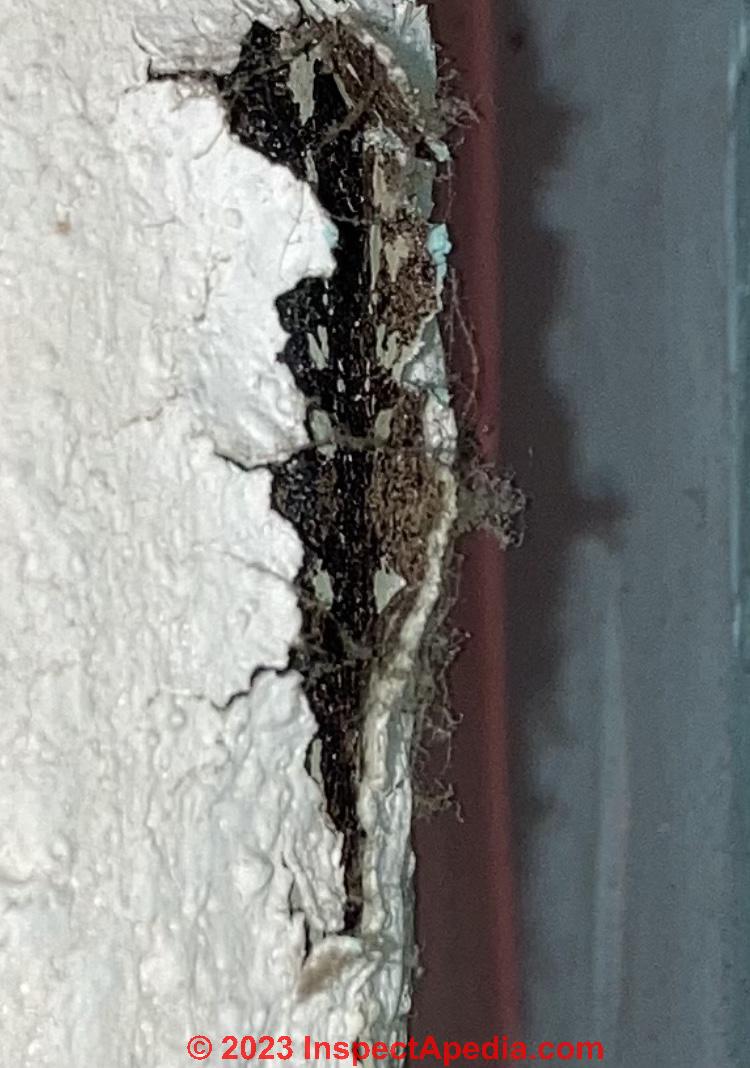
I rent in an old building in NYC (I believe it was built between 1900 and 1920). I am newer to this space and have recently noticed that the wall behind my radiator in my bedroom (pictured) looks like it's melted through several layers of paint over the decades. I am worried that the thick, grey material gathered below the melted wall/the wall contains asbestos.
The wall itself looks like it has several layers of materials, one of which is glossy and stucco-like in appearance. Also, the steam pipe in the room (pictured) is of concern. Can you advise on whether these materials look like they might contain asbestos?
This is particularly worrisome, as the radiator lets out steam all day long, near the damaged wall.
Thanks so much, On 2023-01-18
by Avery
a couple more photos forthcoming. Another of the pole here. For more info, it's about 3.5 inches in diameter and it emits heat.
by InspectApedia Publisher
@Avery,
I don't know what that material is. Zooming in it's a bit blurry. But it doesn't look like a typical asbestos product.
Confirm that this is corrugated asbestos paper pipe insulation
Hi, I recently purchased a 1900 home and we’re planning to have the wrapping removed from our ancient boiler pipes.
Several professionals have told us they’re certain it’s asbestos. Wondering if it’s worth testing before the big abatement expense though?
It looks like the corrugated asbestos wrap I’ve seen described in this forum. Thoughts? Any help would be much appreciated! On 2023-01-18 by Sam V.
and here’s the boiler
Confirmation by InspectApedia Publisher - Yes that is 'corrugated' asbestos pipe insulation and boiler lagging
@Sam V.,
That pipe insulation is almost certainly asbestos. I appreciate the validity of some folks, often people who get paid to inspect and test, who say "you can't identify asbestos for sure just by looking at it with the naked eye. You HAVE to do a lab test.
My response is "Really?" I agree that that's generally true, but there were some products, and this pipe insulation is one of them, that were never made out of non-asbestos in a manner that looks exactly like what's shown in your photo: whitish-gray "corrugated paper" like pipe wrap with a cloth or other lagging covering.
That's asbestos pipe insulation.
Thank you for the helpful question and photo.Watch out: unless someone has already replace the original lagging - a plaster like insulating coating all over the exterior of that boiler - the original lagging will usually contain a significant amount of asbestos. Don't disturb it.
Please tell us the country and city of location and the age of the building where that boiler and pipe insulation are installed.
by Sam V.
@InspectApedia Publisher, many thanks! Appreciate the fast advice
Is this asbestos insulation around our radiator pipes?
Any idea what this is? I found it in a small space above the door to my bilco door, around our radiator pipes.
I also notice what looks like fiberous material around more exposed sections of pipes so im wondering if a past owner removed most of it and left this more enclosed section. If so, should we have it removed or left alone? On 2022-12-15 by Jason
Identification by InspectApedia (Editor) (mod) - asbestos insulation remnants on pipe
@Jason,
I'm not sure about all the stuff I see in your photo but at least in the upper center that looks like pipe insulation that could be asbestos.
Where is the building and how old is it.
YES leave it alone for now.
Asbestos is safe and legal in buildings as long as it's in good condition and not being disturbed.Followup by Jason
@InspectApedia (Editor), its in Eastern Pennsylvania, and the building was listed as 1900s when we bought the home earlier this year. Its impossible to really asses how intact it is without pulling off some old planks underneath.
Our washer and dryer is not far from that space on rhe next floor so i was concerned about dust being kicked around from the vibrations. I also included a second pic of the pipes that likely had the same material removed.
The pipe is only around an inch thick for reference. Are those remaining fragments also a concern?
Advice by InspectApedia (Editor) (mod) - how risky are small amounts of asbestos insulation left on pipe?
@Jason,
That photo is almost certainly a left-over scrap of asbestos pipe insulation.
Watch out: my concern when I see incomplete asbestos pipe insulation removal is that it was evidently not a job done by a trained professional - a pro should not leave asbestos in place on pipes like that and often they'll also use an encapsulant paint to lock down any remaining dust at the end of the job.
So the risk is that an amateur asbestos rip-off job may have contaminated the building.
I would:
- look for other examples of this work and if you're finding more of them you might want an onsite evaluation by an asbestos abatement company
- consider collecting 1 or 2 representative samples of settled dust to screen the building to be sure that there is no worrisome asbestos dust contamination that needs to be cleaned-up.
DO NOT PANIC about this - the panic would be a greater health worry than that asbestos scrap.
Do keep me posted.by Jason
@InspectApedia (Editor), thanks for the help! Just had a consultation with a removal professional. He wasnt too concerned about contamination, in part because there isnt much left and we dont know how long ago it was removed.
I think it could have been as recent as 2018 when a flipper installed a new boiler but it could have been much older.
Going to have them clean up and paint seal the exposed pipes and add some fiberglass insulation to close up the gap where those pipes that are still covered are sitting.
Also getting a hepa air purifier just as an extra precaution. Our house is all old hardwood floors anways so most dust should have been removed over the years from regular cleaning.
by InspectApedia (Editor) - asbestos scraps left on pipe indicates improper / amateur asbestos abatement job
@Jason,
Thanks for the additional details. I agree that hard surfaces are much-easier to clean of dust of any sort.
Given the signs of an amateur asbestos-removal-job in the first place, keep alert to discover other short-cuts or snafus.
No asbestos in 100 percent magnesium carbonate pipe insulation?
I have several stickers that say 100 percent magnesium carbonate. Does this mean no asbestos? On 2022-11-27
by terrance
by InspectApedia (Editor) (mod) - Right: magnesium carbonate asbestos (or not asbestos) pipe insulation
@terrance,
Thanks so much for the photo and Magnesia pipe insulation question. 100% MgCO3 won't contain asbestos but we warn that other products containing the same material did contain asbestos.
See details and your photo at
MAGNESIUM CARBONATE ASBESTOS PIPE INSULATION
What kind of insulation is in this photo?
Thank you for all the information on this website, it's been very helpful with getting to grips with the old house we just moved into.
Our house was built in 1929. Recently I had some insulation work done that required the contractors to move a work bench in the basement.
In doing so, they revealed the Steam Heat pipe in the picture I've attached.
I'm having trouble telling what sort of insulation it is, it doesn't seem to match any of the photos on your site, do you recognize it at all?
On 2022-11-24 by Matthew
by InspectApedia (Editor) (mod) - multiple insulating materials on and around pipe
@Matthew,
There are at least two, maybe three insulating materials that I THINK I can see in your photo, annotated in a copy of your image.by Matthew
@InspectApedia (Editor), uff, I didn't even notice that possible asbestos remains on the pipe, thank you for taking a look at the image and annotating it like that!
by InspectApedia (Editor) (mod)
@Matthew,
Glad to assist - working together helps us both.
About those possible asbestos remnants, it'd be no surprise to find a few tiny bits of asbestos on piping even after a professional asbestos remediation. On a 1929 home it's likely that asbestos pipe wrap was on the original heating or hot water pipe installation.
In my OPINION a little better job - still possible - is to spray-paint the cleaned, exposed piping so that any remnants are immobilized. There should be no meaningful asbestos hazard from what we're seeing.Of course we don't know what's under that foam but even if it's an asbestos wrap, it looks encapsulated.
What is the hard insulation around this pipe?
What would be hard packed inside this material wrapped around the pipe? Resembles dark clay almost, holds form, owner says it's not asbestos. House built in 1890. Curious.
On 2022-11-17 by Kne
by InspectApedia (Editor) (mod)
@Kne,
I looked at your photo, even zoomed in, but I can not make out ANY of the actual pipe insulating material. What we see is a fabric wrapped over "something" and sealed at one end with what looks like silver duct tape.
Take a look at the asbestos pipe insulation illustrated at ASBESTOS PIPE INSULATIONYou can compare that to what you're seeing.
Or perhaps you can add a photo of the end of that wrapped stuff on the pipe so that we might have a better look.
While a lab test is generally required to confirm the identity of asbestos in many materials, SOME asbestos pipe insulation like that shown at the very top of the article I ccited just aboe is un-mistakable since there was not another non-asbestos insulation used on piping and that looks the same.
Is this brown hairy insulation asbestos?
Is this possibly asbestos.
On 2022-11-14 by Martin
Reply by InspectApedia (Editor) (mod) - No, coarse brown fibers are not asbestos
@Martin,
That coarse brown fibrous material won't be asbestos. It looks a lot like jute or another organic insulating material.
Is this paper type insulation on pipes asbestos?
Wondering if this paper type insulation I took off my pipe in our crawl space is asbestos. I wore a respirator but yeah it was definitely floating around a bit.
Had no choice but to remove and replace the heat shrink underneath.
On 2022-11-07 by Guy
Answer by InspectApedia (Editor) (mod) - No, fiberglass pipe wrap insulation is not asbestos
@Guy,
It looks like fiberglass pipe wrap
Is this paper liner from a 1930's hot water heat convector radiator asbestos?
I found liner material inside my hot water convector radiator from the 1930s and an worried if it's asbestos
I was cleaning the fins before turning the heat on for the season and noticed what looked like paper between the fins and the front metal strip that is part of the housing for the fins. the house is super old and these are original radiators so I thought maybe a kid stuck paper in there.
used a flat head screw driver to try and push the paper out but when a chip fell to floor I saw it wasn't paper. the brown side faces the fins and yellow was the v dude attached to metal strip.
Again this liner or whatever it is is from 1930s. I cannot find anyone who can identify if it had asbestos in it not even Trane Hvac businesses. On 2022-10-31 by Grace
by InspectApedia-911 (mod) - does liner material inside my hot water convector radiator from the 1930s contain asbestos?
@Grace,
I'm sorry to say that from just your text and photo nobody can make an absolute statement about whether or not the little scrap of paper in that plastic bag contains asbestos or not.But its tan color certainly doesn't *look* like any asbestos paper products that we've been able to find in both field inspections and research.
Asbestos in paper and board forms was used in many heating system components and could have been a heat-insulating backer in a heating convector though in that location in thin paper form, it'd have had so little value that I am doubtful.
It would be more-helpful to see a photo of the heating convector unit in-situ, showing that tan paper in-place and in-use, presumably from which your little scrap sample was torn.
While you'd have to have a lab test done to prove for sure that your scrap is just paper not asbestos, you can see photos of what asbestos paper looks-like at
ASBESTOS PAPER DUCT INSULATION
Asbestos was used with thin kraft paper in some insulating products shown for example in this PDF from 1947
inspectapedia.com/insulation/Infra-insulation-1947.pdf
from which the crinkle insulation image below has been excerpted.
Typical heating convector construction and features are described at
WALL CONVECTORS HVAC
also take a peek at
ASBESTOS USE in APPLIANCES
Is this yellow fibrous heating pipe wrap asbestos-related?
Hi, Wondering if this is asbestos related, it was used to wrap the pipes going from radiatior to radiator. Thanks, Fabio
On 2022-10-25 by Fabio C
Answer by InspectApedia (Editor) NO, that's fiberglass insulation
@Fabio C,
That looks like fiberglass
Is this old boiler flue wrap material asbestos?
Hi. I wonder if this is Asbestos.
I saw this in someone's loft. It was wrapped around an old oil boiler flue. Someone has bagged the flue up and left in a void within the house.
There is a picture zoomed into some that I can see on the floor in the void. The picture of the flue is hard to see but I didn't want to take out of the wrapping. Thanks.
On 2022-10-07 by James Durley
Reply by InspectApedia-911 (mod) - Looks like fiberglass and something else we can't ID from your photo
@James Durley,
That yellowish material is almost certainly fiberglass. It looks like there's some white stuff on the fiberglass but I can't quite make that out.
What's the yellow pipe insulation adjacent to the corrugated paper asbestos pipe wrap in this photo?
I know that I have some old radiator pipes wrapped in asbestos, but would like confirmation that the other insulation with the yellow coloring is not asbestos.
Also I am assuming the yellow colored powder is most likely fiberglass and not asbestos. Can someone confirm this for me? I am attaching 2 images (I think).
On 2022-10-03 by Steve Schultz
Answer by InspectApedia-911 (mod) - white corrugated paper-like material is probably asbestos pipe insulation; the yellow is fiberglass pipe insulation.
@Steve Schultz,
The white corrugated-paper-like material in your photo is probably asbestos pipe insulation.
The yellow material is probably fiberglass.
What is this yellow sticky pipe wrap? Asbestos?
When we moved in the inspector was not sure if this wrap was asbestos. I really would appreciate your input because my kids are starting to play more on that area and I need to know if it’s safe. On 2022-09-30 by Saddie
Answer by InspectApedia-911 (mod) - stick on wrap type pipe insulation
@Saddie,
That looks like a stick on wrap type pipe insulation. One cannot save from the photo whether or not it contains asbestos. But it would be useful to know the age and location of the building and a guess at the age of the wrap on material.
In any case if it is that the sticky type pipe wrap, it's not friable.by Saddie
@InspectApedia-911, the house was built in 1969, suburbia of Chicago. Hope this helps. When you say friable - what exactly do you mean?
by InspectApedia (mod) - if not friable, there is little asbestos concern
@Saddie,
Friable means easily crumbled between your fingers, i.e. easy to make into a dust or small particles.y Saddie
@InspectApedia , definitely not friable then. but I do see it was cut into in this and one more spot. based on the age and location of the house - do you think it contains asbestos?
by InspectApedia (mod)
@Saddie,
It is not a friable material, so even if it contains asbestos you'd be hard-pressed to detect a hazardous asbestos fibre or dust release from such a product under normal conditions.
DOES THIS MATERIAL CONTAIN ASBESTOS? - 5 easy questions to tell if a BUILDING MATERIAL probably contains asbestos
can help you provide more contextual information that addresses the asbestos question.
Is this UK Pipe Insulation Asbestos?
By private email to the editor MM asked:
Are you able to identify the attached photo of the following as asbestos?
[Sent from the UK - Ed.]
On 2022-09-25 by MM:
Reply by InspectApedia (Editor) - dark gra / black felt-like insulation?
@MM
Thanks for the question and photo - sorry, but no we cannot assert that the pipe insulation in your photo is asbestos.
That dark gray material is not familiar to us. In my OPINION it looks like felt. Comparing it with the asbestos pipe insulation on the page above we don't see a resemblance
It could also be a cellulose material.
Short of an asbestos lab test, a sharp-focused close-up might allow us to offer a more-interesting opinion.
Chances of asbestos pipe wrap in a 1908 Chicago home
Could you please help us identify if the pipe insulation containing asbestos?
The house was build in 1908 in Chicago. The previous owner did a full renovation in ~2000. I dont' see any other (old) materials between the pipe and new wrap material.
On 2022-08-19 by Max
Advice by InspectApedia-911 (mod) - pipe insulation looks newer
@Max,
That looks like a rather new wrap on those pipes, possibly covering old pipe insulation and yes that older insulation may contain asbestos, though I can't see enough to have a confident opinion.
It would be helpful to know the country and city of location of the building and the building age.On a 1908 house it's quite likely that asbestos pipe insulation would have been used on heating pipes and sometimes on water pipes too.
It's also plausible that a prior owner had asbestos pipe insulation either removed, or some removed and some encapsulated.
Your pipe wraps looked pretty new, hence my prior opinion.
Sometimes a careful inspection can find evidence of (incomplete) asbestos insulation removal - bits left at elbows and in hard-to-access areas such as where pipes head up into ceiling or wall cavities or down into enclosed floor cavities.
Identify this pink and yellow fibrous insulation in a 1969 Camper
1969 Cardinal Camper, I'm unsure if asbestos comes in a yellow fiber texture. The pink in the photo is new standard insulation. The yellow is what I'm unsure about.
On 2022-08-12 by Anonymous
Answer by InspectApedia (mod) - two brands of fiberglass batt insulation
@Anonymous,
Your photo is showing two different brands of and colors of fiberglass insulation.
Identify yellow/tan crumbling insulation on old pipes in a 1914 home
On 2022-08-08 by Dan
I'm wondering about this powdery substance that was used to insulate heating pipes in a circa 1914 house. It is powdery with fine, soft particles.
The house is from around 1914 and this is powdery; pieces easily rub/break off and turn to dust. Is that likely to happen with foam insulation. Seems more like a fine sawdust, but not quite.
Suggestions by InspectApedia-911 (mod) - brown powdery insulation possible materials include:
@Dan,
Looks like UFFI foam or even wood fiber/cellulose: Compare your insulation with the descriptions of material describedat BALSAM WOOL INSULATION (best guess)
at FIBERBOARD SHEATHING IDENTIFICATION and
at UFFI, HOW TO IDENTIFY in BUILDINGS
Boss said this pipe wrap is animal fiber in a 1929 North Carolina Home
So our boss claims he tested this pipe wrap and it came back as animal fiber. I have a very hard time trusting this guy and at this point call b.s....... His only concern is everybody works. I feel he is putting the whole crew at risk requesting it to be removed.
The home in question was built in 1929 in N.C. And the insulation is a wrap around boiler pipes.
I included a image I snapped today. Would I be in the wrong to remove a sample and have it tested it myself? I’m no expert but I have concerns on the material. On 2022-08-02 by Aaron
Asbestos identified by InspectApedia-911 (mod) - That's not animal fiber; compare with corrugated asbestos paper with an external wrap or skin
@Aaron,
That's not animal fiber.
The innner insjulation wrapped in cloth fabric looks like a perfect match for corrugated asbestos paper with an external cloth wrap or skin.The white crumbly pipe lagging in the lower center of the photo also looks like an asbestos-based pipe insulation often used at joints, pipe elbows, and on boilers.
I'd like to see a better photo in which you use a flash so that you can light up the end of the insulating material.
But you can certainly compare it with the photo shown here.
This is one of the few materials that can be reliably identified by visual inspection as asbestos corrugated paper because there was no look alike product that looks exactly the same but that was not an asbestos material.
Identify brown flaky powdery insulation in batts with black paper wrapping
First, thank you so much for this wonderful resource!
I'm looking for help identifying the insulation in this image. House was built in ~1950 in Michigan.
Unknown if this section of cast iron sewer pipe is original, although we believe it is. This is the main sewer line descending from the first floor of the house into the basement. It looks like balsam wool to me, but wanted a second opinion. Thanks - On 2022-06-28 by Andrew
Answer by InspectApedia-911 (mod) - That's balsam wool insulation
@Andrew,
That brown fibrous insulation is almost certainly a Balsam wool product. in insulation "batts" wrapped in a black paper barrier; That's a wood fiber, material, not asbestos, a mineral.
On 2022-06-18 by Steve
House was built in 1945 and expanded in 1970. Found some of this on a hot water pipe. Black plastic over filling which may or may not be asbestos.
On 2022-06-18 by InspectApedia-911 (mod) - cellulose insulation
@Steve,
Looks like cellulose. Take a closer look for bits of newsprint.
On 2022-06-12 by Jim
Hi found this wrapped around radiator pipes inside wall while removing radiator.
is it possible asbestos?
On 2022-06-13 by InspectApedia-911 (mod)
@Jim,
That brown and white coarse fibrous material is far more likely to be jute or hemp insulation and fiberglass or similar product.
On 2022-06-08 by David wild
Hi this is behind my fuse box, house is circa 1960 I'm unsure whether it's wood or hopefully not asbestos board. It has suffered from what looks like woodworm but is in poor condition.
On 2022-06-08 by InspectApedia-911 (mod)
@David wild,
If you're referring to that brown fibrous stuff in the center of your photo that looks like fiberboard. Typically a wood product.
On 2022-05-019 by Daniel Heyman
Found this during loft conversion, it sits under the gutter around the roof. Builder thinks it was put in 25 years ago or so, but just wanted to check it's nothing nasty.
by Inspectapedia Com Moderator (mod)
@Daniel Heyman,
I'm unclear what you're asking about: that stucco-like material or the smooth, broken board (maybe fiber cement or asbestos cement?)by Daniel
@Inspectapedia Com Moderator, yes the smooth white material next to the vent. The builder thinks it isn't asbestos and was put in about 20 years ago.
Is there a way to distinguish between fibre cement and asbestos?
by InspectApedia-911 (mod) - How to distinguish between non-asbestos-containing fiber cement board and asbestos cement board or millboard
@Daniel,
Thanks, that's a great question: can we distinguish between non-asbestos-containing fiber cement board and asbestos-cement board.
The short answer is ... it depends, or "sometimes".
IF we knew that the date of a building's construction was definitely after asbestos cement products were no longer being sold in your country
or
IF we had sales receipts for the work showing its materials-purchase-date was after asbestos cement products were no longer being sold in your country
Then you could make a reasonable guess at "not-asbestos".
OR
IF you had a lab test of a representative sample of the material that'd answer the question - FOR THAT PIECE ALONE.
I'm fussy on this point because it's absolutely the case that there were some fiber-cement products such as building siding panels that were made after asbestos was no longer being used but that look absolutely identical, otherwise, to their older sisters who contained asbestos.
So in the case of your home, if it's date of construction is from when asbestos cement board was being sold in your country AND if you have every reason to think the material in your photo is original, most-likely it contains asbestos.If you decide to have that cement board tested for asbestos, do let us know the results, as that will assist others. Certainly if the age of the home dates (in the U.S. before 1986) the cement board is probably an asbestos product.
It's not friable. Just avoid making a dusty mess by sawing, grinding, etc.On 2022-05-20 by Daniel
@Friedmandaniel911, thanks very much for the info. Builder thinks it was put in 20 years ago, after asbestos was stopped, but I'm not sure what his basis is for that. I might send a bit to a lab.
On 2022-05-16 by Jay
Wondering if this looks like asbestos. It is on a roof drain line in a church built in 1970.

I can't say anything about that little bit of white material showing in your photo.
If you can expose the END of that white material you can compare its appearance to corrugated asbestos pipe wrap shown in the article above.
On 2022-05-17 by InspectApedia-911 (mod)
@Jay,
The brown fabric looks like burlap or jute pipe wrap to me.
On 2022-05-10 by Jack
Do these pipes look to be asbestos pipe?
by Inspectapedia Com Moderator (mod)
@Jack,
That could be transite asbestos piping. How old is the building and where is it located?by Jack
@Inspectapedia Com Moderator, The home was built in 1951. This is located in the attic, the one on the left was for an old furnace and the round pipe on the right is the exhaust for a water heater. Property is located in San Diego CA.
by Inspectapedia Com Moderator (mod)
@Jack,
Thanks - that plus the details we can see all argue for transite pipe used as a vent
take a look at TRANSITE ASBESTOS CHIMNEYS, DUCTS, PIPES https://inspectapedia.com/chimneys/Transite_Asbestos_Chimneys.php
On 2022-04-28 by Lindsey N.
Asbestos or fiberglass? Wrapped around old water pipe. House built in 1956, original pipe.
On 2022-04-28 by Inspectapedia Com Moderator (mod)
@Lindsey N.,
Fiberglass
See
INSULATION IDENTIFICATION GUIDE
https://inspectapedia.com/insulation/Insulation-Identification-Guide.php
And on that page take a look at the fiberglass insulation photos
Is this cracked, flaking insulation on pipes asbestos? Princeton New Jersey
Wondering what this pipe insulation could be. We are renting a house that's been up since at least the 60's and this is the insulated portion of the exhaust for our furnace. It's cracked and the inside is this yellow/white material that turns into fine powder if you touch it and roll it in your fingers. Any insight would be helpful. Thanks!
On 2022-04-18 by jprows1
Answer by Inspectapedia Com Moderator
@jprows1,
I don't recognize that material. It's possible that it is or contains asbestos. It's also possible that there's a leak in the piping that is leaving an efflorescence salt on the surface.
You might want to have a sample tested by an asbestos lab before disturbing it. If you do that let me know what you're told us that will assist others.
We'd also welcome some other photos, and it would be useful to know the age and location of the building where this insulation is installed.On 2022-04-19 by jprows1
@Inspectapedia Com Moderator, @Inspectapedia Com Moderator,
Thanks so much for getting back to me. I'm not exactly sure of the age of the building. I did a quick online search and it seems like it was built anywhere between 1900 and 1930 and it is located in Princeton Junction New Jersey.Here are more photos of the pipe from the Furnace. One is of some of the dust that came off. I think my cat's may have disturbed it.
by Inspectapedia Com Moderator
@jprows1,
There is a reasonable chance that that material is or contains asbestos - just from its physical appearance and context of use. Experts will probably spend your money to have a sample tested - which I agree is a reasonable step.by jprows1
@Inspectapedia Com Moderator, Thanks again for getting back to me.
Assuming it is asbestos, how concerned should I be and what immediate precautions should I take while I am waiting for it to get tested. The pipe insulation is in the laundry room which we are in multiple times daily. How concerned should I be if it were asbestos?
by Inspectapedia Com Moderator - flaking off pipe insulation requires appropriate safety steps
@jprows1,
While no one can make a reliable building safety assessment based on a few photos alone, some of your photos show fine particulate debris shedding - so if that's asbestos, in any volume, you could be creating a hazardous dust needing more-extensive cleanup.And in a laundry I worry about a clothes dryer drawing hazardous dust into its air intake and through clothing.
It'd make sense to clean up using damp wiping and HEPA vacuuming.Often an expert will encapsulate or reduce particle shedding, even if only partly effective, simply by a light spray coating of a sealant paint or encapsulant (described in our Index to Related Articles).
To be clear, from what we see to this point I can't be sure even what is the material that we're seeing. I can't say if it's an insulated metal pipe or a deteriorating clay flue tile liner or something else .
Identify this 1990's Felt-Like Insulating pipe wrap on a 1950's London Home
1950s London house but had work done in 1990s. Are these pipes covered in asbestos?
On 2022-04-07 by Danielheyman123
Reply by Inspectapedia Com Moderator
@Daniel,
That's not a pipe insulation that I can identify with certainty but
It looks most like a pipe wrap made of recycled materials, perhaps fabrics or felt, but possibly also including some cellulose - used as a pipe lagging insulation. Typically those are made of wool or a mix of recycled wool and/or other fabric fibres.
In your photo (above) we can plainly see the edges of the wrap so we know it's a wrap-around pipe insulation, not a sleeve nor spray-on.
Recycled pipe wrap insulating fabric mix can, from a distance also look like insulation made from cellulose (wood or paper fragments) but it's not likely to be of cellulose.
See if you can get a very sharp close-up photo (you can post one photo per comment but as many comments as you need).
Look for evidence of use of chopped chopped fabric and also (unlikely) look for newsprint - tiny bit of paper with letters on them.
In the UK you may find that pipe insulation advertised as "cellulose or recycled rag or fabric pipe lagging" or as felt insulation, usually made of recycled cloth, sometimes specifically wool.
More about cellulose insulation used as a loose-fill in walls and ceilings is at
CELLULOSE LOOSE FILL INSULATION
but we direct you to our page on
SHEEPS WOOL INSULATION
where we'll include this discussion so as to invite further reader or expert comment.
Shown below are two examples of currently-available felt pipe lagging described as "Felt Insulation Hose (left in image) or as Pipe Lagging Wrap - natural wool (at right)" currently sold by online vendors.Closer look at London pipe insulation wrap by Danielheyman123
A closer up image of the pipe insulation posted below. Many thanks for the advice. Sounds like it's not asbestos
by Inspectapedia Com Moderator - multi colored pipe wrap insulation may be recycled material - "felt" pipe wrap
@Danielheyman123,
Thanks for the sharper photo; agreed, not likely to be asbestos from appearance, texture, strength, application, etc.
The multiple colored fragments argue for recycled rag or fabric.
Identify this brown layered flaking pipe insulation
Pipe insulation on a domestic water line. Not sure of the age. 75 percent of the room was wrapped in old glass and 1 wall had this style insulation on. All wrapped in seemingly the same cloth.
On 2022-02-24 by Reggie F
by Inspectapedia Com Moderator - Brown corrugated pipe wrap insulation may contain asbestos
@Reggie F,
Comparing your photo with the most-common form of corrugated asbestos paper pipe insulation (see page top illustration) we can see that your pipe insulation looks like corrugated paper too, but tan-brown while the photo at page top shows that pipe-wrap asbestos is usually grayish or whitish in color.
We did have a reader who reported a lab test finding asbestos in brownish color insulating wrap.
So my best advice to you is to have a sample of this material tested by a certified asbestos test lab. Please let us know the results as that will assist other readers as well.
On 2022-02-17 by Katie
Is this asbestos wrapped pipe damaged and possibly toxic to breathe? I found it today and I feel sick over it!
by Inspectapedia Com Moderator
@Katie,
That might be a cloth covered asbestos insulated pipe but I can't tell from your photo. It's usually diagnostic if we can see in end of the insulation somewhere.
Take care to try not to feel sick with anxiety about this as the anxiety may be a greater health hazard.
Asbestos is safe and legal and can be left in properties when it is undamaged and undisturbed.
Identify this "plaster" like pipe insulation wrapped in fabric - asbestos?
I have this around a copper water pipe in my basement. It looks like plaster with a fabric wrap. Any thoughts on asbestos?
On 2022-01-30 by Andy
Reply by Inspectapedia Com Moderator
@Andy,
I'm actually not sure what that insulating material is.
You will see at ASBESTOS PIPE INSULATION that traditional asbestos pipe insulation looks like a light grey corrugated paper, with a cloth exterior wrap.
An asbestos-based plaster was often used at pipe joints and elbows and sometimes as a complete covering on the exterior of boilers.
I haven't seen a cast asbestos plaster solid material used as pipe insulation so I'm not sure what your insulation is.More likely we're looking at
MAGNESIUM CARBONATE ASBESTOS PIPE INSULATION
If you can tell us the country and city of location and the age of the building where this material is installed that would be helpful.
Meanwhile with no other information I have to err on the side of caution and tell you to treat that material is presumed to contain asbestos until you've had a sample tested.
If you do test it, let us know what you find, as that will assist others.
Identify this gray pipe insulation used in Hertfordshire in a 1938 building
Hi, I have this insulation in my bungalow loft, I think it is fiberglass but would like a second opinion. Thanks Steve
On 2022-01-29 by Steve
Reply by Inspectapedia Com Moderator - probably felt or similar with risk of asbestos at center
@Steve,
The photo is not sharp enough that at magnification I can see much detail, but it does look like a fibrous insulation, perhaps felt, less-likely, mineral wool. It does not resemble the corrugated asbestos paper insulation illustrated at ASBESTOS PIPE INSULATIONNone of it looks like fiberglass unless perhaps in the exterior wrapping.
That inner core gray material might be identified by a larger, sharper photo.
Watch out: The innermost core that's white might be asbestos-suspect.
Knowing the building country and city of location and building age would be helpful.by Inspectapedia Com Moderator
@Steve,
Thanks
A sharp photo that lets us see a fibrous character might point to mineral wool;
Traditional asbestos pipe insulation is either the corrugated asbestos paper shown at ASBESTOS PIPE INSULATION or a plaster-like asbestos-based lagging used at pipe elbows and sometimes to cover entire boiler exteriors.
by Steve
@Inspectapedia Com Moderator,
Thanks, the village is Cuffley, Potters Bar, Hertfordshire. in Hertfordshire and the building was built in 1938. I'll try and get a better photo.
by Steve
Hi, this is a better view of the pipe insulation, 1938 bungalow loft, looks more like fiberglass? Any help would be appreciated. Thanks.
by Inspectapedia Com Moderator
@Steve,
Given the age of the material I wouldn't rule out that asbestos was used at least for the inner liner and possibly part of the other wrap. The main grey body looks like a course fibrous material mixed with some gray material that could be cellulose.
In other words, thank you very much for showing us is an insulation product on pipes that I haven't seen; I'm not sure what it contains.
If you decide to have it tested or asbestos content, you need to be sure that all of the 3 different materials are tested. There seems to be three layers.
On 2022-02-14 by Moderator: asbestos found in inner core of UK pipe insulation in 1938 Hertfordshire home
Though we can't identify the gray core in your insulation from just a photo, it looks like cellulose or mineral wool, and that outer core may simply be a coated fabric, perhaps using fiberglass or a synthetic material.
In that location there is little chance of that inner core of asbestos (asbestos paper or fabric?) creating a detectable airborne asbestos hazard in your building as long as the pipe insulation is left intact, un-damaged, in-place.
If the pipe insulation must be removed (as it appears someone has done with the example in your photo) then you'll want to treat it as an asbestos-containing material - proper handling, disposal, and cleaning of the exposed pipe surfaces before re-insulating.
On 2022-02-14 by Steve - confirming asbestos found in inner core of the pipe insulation shown below
Update on my pipe insulation, bungalow loft built 1938,
I had all three parts of the insulation checked and they found Chrysotile asbestos in the inner core only.
Thanks for your help and advice.
by Inspectapedia Com Moderator
@Steve,
Thank you, that update will assist other readers who have similar asbestos questions about insulation in their home.
In that location there is little chance of creating a detectable airborne asbestos hazard as long as the pipe insulation is left intact, un-damaged, in-place.
If it must be removed then you'll want to treat it as an asbestos-containing material - proper handling, disposal, and cleaning of the exposed pipe surfaces before re-insulating.
What's this white stuff covering a radiator pipe?
Any clue what this could be? Surrounding a radiator pipe that runs from the ceiling into the floor (where this photo is taken).
In a main room, but there’s always been something in the corner that prevents much use of that part of the room. Planning on getting this tested, as well.
On 2022-01-21 by GH89
by Inspectapedia Com Moderator
@GH89,
I think you're asking me about a band of material that I can make out surrounding one of the pipes at floor level in your photograph. It's probably an insulating material.
I'm guessing that you're concerned about asbestos. What is exposed is a trivial amount, in an area difficult to touch and certainly not likely to be disturbed, at best, left in place and simply covered over.
Of course if you decide to have it tested let us know what you find.
Remember that asbestos is safe and legal in buildings as long as it's not being disturbed into an Airborne hazard.
On 2022-01-06 by Nicole L. Identify this brown insulation material in a1954 Illinois home - is it asbestos?
Hello, I have some insulation-type material falling down from my pipes in my 1954 Illinois-suburbs house. Asbestos?
by Inspectapedia Com Moderator - not asbestos; balsam wool
@Nicole L., The brown fibrous material with black kraft paper backing looks like a balsam wool product.
by Nicole L.
@Inspectapedia Com Moderator, thank you! You all are amazing. I also found the link on your page that describes this material in more detail.
On 2022-01-04 by Chrishindle95
Hi, just noticed this material wrapped around some old pipework in my cellar (1870's Victorian terrace house)
and was wondering if it is likely to be asbestos containing?
I've added a close up photo which hopefully give a bit more clarity but will get it tested.
Warning by Inspectapedia Com Moderator - asbestos paper & stick-on insulating pipe wrap
@Chrishindle95, that may be an asbestos paper insulating wrap. The photo is a little uncertain.
It would make sense to treat that material as presumed to contain asbestos.
You may want to look more carefully at all of that piping as it looks extremely rusted.
In my Minneapolsi home, what is this insulating tape on pipes & does it contain asbestos?
Wondering what this tape is all about and if it might have asbestos? It smells very moldy and old and is chipping off in chunks. Located under the stair in a home built in 1960 in the suburbs of Minneapolis. Would love to replace it to rid the smell, if possible
On 2021-12-29 by Lee
by Inspectapedia Com Moderator - possible asbestos in pre-1986 stick-on pipe wrap insulation
@Lee,
Yes that insulation, installed in the U.S. before 1986, may well contain asbestos.
On 2021-12-11 by Anonymous
1830s house; the insulation around pipes probably from the 1930s based on some newspaper I found wrapped around some. Does anything here look like asbestos?
On 2021-11-24 by Inspectapedia Com Moderator - Is the mastic insulating the pipe joints asbestos?
@Jack,
It looks pretty recent; you'll want to get more data - the country/city of location, when that country stopped using asbestos, the age of the building, the age of the work - or have samples tested.
Or find an exposed end of the pipe insulation so that we can see what the insulating material actually looks like.
Compare what you see to the corrugated asbestos paper pipe wrap shown at ASBESTOS PIPE INSULATION
On 2021-11-24 by Jack
Is the mastic insulating the pipe joints asbestos? It’s rock hard and not fiber outs.
On 2021-11-21 by Inspectapedia Com Moderator - Jute is a plant fibre, not asbestos
@David wild,
That looks like jute. It's certainly not asbestos.
On 2021-11-21 by David wild
Hi I posted previously about pipe lagging and this is the sample I have collected. It's wrapped in white tape and has the look of hair
On 2021-11-07 by Inspectapedia Com Moderator (mod)
@Joel T.,
That looks like a simple fiberglass pipe insulation wrap.
On 2021-11-07 by Joel T.
Is the insulation on this copper pipe something to be concerned about? The house was built in the early 1970s in Michigan.
On 2021-11-03 by Inspectapedia Com Moderator (mod) - does my Burnham boiler have any asbestos in it?
@Lee B,
We can see fiberglass or possibly a mineral wool insulation in your photos.
If you are seeing some white cementious material, it's possible that it was used as a sealant at some location in the heater.
Some of those sealants contain asbestos depending on the sealant or heater age.
On 2021-11-03 by Lee B
Bought a house with an old, unknown age, Burnham boiler. V-33. No serial number on plate.
Left side of boiler appears to be yellow fiberglass. Pipe-In
Right side (looks like some exhaust blow-by because very dirty looking) might be the same fiberglass, but very dirty? But what is that broken up hard stuff? Asbestos?
Thanks in advance!
On 2021-10-15 by inspectapedia.com.moderator (mod)
@Trin,
So we don't know if the corrugated paper is asbestos or not. In any event the amount that is exposed is trivial.
On 2021-10-15 by Trin
@inspectapedia.com.moderator,
Thank you so much. I bought the plates you advised and set them on the pipes. Beforehand I carefully vacuumed around and thought about how many times I did that hitting those pipes - how much danger could this represent? Could I not intentionally damaged the material with this and asbestos was put in the air?
And a reply on your comment. Those pipes actually never had insulation as such around them because they are the thin radiator pipes in rooms - it starts only when you see it where it goes in to the floor.
On some you don’t even see it because installation was made before putting the concrete - this is weirdly written but I don’t know how to explain it.
I forgot to mention before but my father said this was a usual cardboard paper they were using to protect the pipes from concrete, paint etc. and also to minimize the cracking sound pipes are making when they are starting to heat.
On 2021-10-14 by inspectapedia.com.moderator - Cover asbestos insulation on pipes at floor in Slovenia
@Trin,
It looks to us as if asbestos pipe insulation was removed where it was easy to do-so: in the room space where you see bare, painted pipe, and that it was left where it was hard to remove - where pipes pass through the floor. See our notes on a clip from one of your photos.
I would seal the exposed asbestos-suspect pipe insulation with a clear spray shellac or varnish and then install a round metal escutcheon plate sold in hinged form that will snap around the pipe and cover those holes in the floor.
Continuing:
Hinged escutcheon plates like the one we show below are sold in various diameters and simply snap in place around the pipe to cover those holes in the floor. A Slovenian plumbing supplier like Termotehnika Ljubljana will have something similar.
On 2021-10-14 by Trin
Hello!
I would really appreciate your input. We live in a house (Slovenia), that was built in late 70’s by my parents. It was refurbished cca 20 years ago and even before ny parents say there was no asbestos used. However I recently paid more attention to the thin radiator pipes in corners of the rooms that go from ceiling to floor and on the floor there is this round protection missing
When taking a closer look I see some sort of insulation. On one picture brown corrugated paper is clearly seen (I don’t know if this could be asbestos) and on the other the material is a bit more detorriated I guess and looks a bit different.
However I think this could be same as its one room to the other. I have a 1 year old son who is now touching and scratching everything and I am terrified if this could contain asbestos.
Can you maybe tell from the photos? I can’t thank you enough.
On 2021-10-09 by inspectapedia.com.moderator
@David,
The photo is a bit dark and blurry, but I see what looks like yellow fibreglass at the edges of a white wrap; if that's fiberglass its wrapping isn't likely to be an asbestos material.
On 2021-10-09 by David
This is in a UK bungalow approx. 1960 under the floor wrapped around hot water pipes
On 2021-10-06 by inspectapedia.com.moderator
 @Peter,
@Peter,
It looks like peeling paint and not thick enough to be a type of asbestos-based plaster-like coating or compound. But of course, one photo without depth or context is difficult to identify.
Adding:
Depending on the age of the paint and the country/city of location, there may be a lead-paint hazard.
On 2021-10-06 by Peter
This is a heating pipe running through my bathroom - anything to worry about?
On 2021-09-28 0 by (mod) - leave asbestos-suspect pipe insulation in place if it's in good condition; encapsulate it?
@Andrew,
That looks like it may be corrugated "paper" asbestos pipe insulation; an end-view of some of the material may be a determinant.
Asbestos is safe and legal to leave alone, in place, in buildings unless it is damaged and shedding material.
Often asbestos-pipe insulation is left in place and encapsulated to protect it from damage.
On 2021-09-28 0 by Andrew
This is in the basement of a house in San Francisco built around 1930ish. Is this a dangerous?
On 2021-09-26 by inspectapedia.com.moderator (mod)
@Gabriel,
Thank you.
We've worked hard on this material for decades, so I'm really grateful when a reader finds it useful and trustworthy.
We also welcome your photos, questions, criticism or suggestions.
On 2021-09-26 by Gabriel
@inspectapedia.com.moderator, ahh yes. I got a closer look at one of the ends and it has the yellow fiberglass. Quite the relief.
Thank you again for sharing. I appreciate it.
On 2021-09-26 by inspectapedia.com.moderator
@Anonymous,
If you're referring the 'white' pipe running across the top of the photo, that appears to be the same material as the pipe I referred to with the exposed end. If so, then my answer is the same - not an asbestos product.
On 2021-09-26 by Anonymous
@inspectapedia.com.moderator,
Not sure if I'm double commenting.
I'm concerned about the top pipe which is the main water line. Any thoughts?
Thank you for your prior reply.
On 2021-09-25 by inspectapedia.com.moderator
@Gabriel,
In the lower near Center portion of your photograph where an end view of the pipe insulation can be seen I see what looks like yellow fiberglass insulation. That's not an asbestos product.
On 2021-09-25 by Gabriel
Townhome built in 1980s I believe. Could someone share their thoughts of it could be asbestos.
On 2021-09-06 by inspectapedia.com.moderator (mod)
@Mel, most likely that's mineral wool insulation
On 2021-09-06 by Mel
We are replacing the pipework in our 1950s built SPAN flat and wondered if this weird stuff around the pipes could possibly be asbestos or if it’s clearly something else?
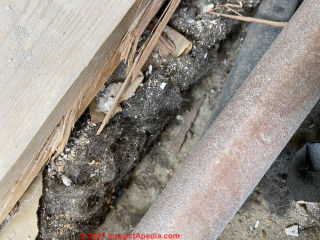
On 2019-05-19 by (mod) - acute short term asbestos dust exposure hazard
Thanks for your remark, Anonymous - I used to think what you do about long-term exposure as the source of Asbestosis.
Unfortunately, recent events like the collapse of the NY City World Trade Center (September 11, 2001) and the dense asbestos (and other debris clouds) and thick after-deposits of inches of asbestos-laden dust (asbestos fireproofing spray was used on the first through 38th lower floors of the World Trade Center) provided a tragic illustration of the error in that "opinion".
After the WTC disaster, the incidence of sarcoidosis or SLGPD was increased among FDNY rescue workers. ( Izbicki 2007)
In sum, **acute** exposure to high levels of asbestos dust, occurring even over a very short time - minutes to hours to days - can ha e extremely harmful effects such as was found in at least some workers who were in the WTC area during and shortly after that terrorist attack.
It's possible for improper work, even on a much smaller jobsite, to create similarly harmful conditions during demolition projects.
However I agree with you regarding other low-risk or no-risk situations, as do other experts such as the US EPA who write that
Asbestos is safe and legal to remain in homes or public buildings as long as the asbestos materials are in good condition and the asbestos can not be released into the air.
We have written throughout this article series, that the probability of a normal occupant or resident suffering asbestosis or similar health injury from the presence of un-disturbed asbestos containing materials such as vinyl or asphalt-based flooring or even pipe insulation (which may be quite friable) - so long as the material is undisturbed and undamaged - is probably below the limits of detection.
In fact my OPINION is that in some cases people's anxiety about such low-risk or even no-risk presences of materials in a building may produce greater health injury (from stress) than the material itself.
Also see our WTC DUST PARTICLE - MICRO PHOTOGRAPHS
Watch out: however. In-expert or amateur DIY "asbestos removal" projects that grind, saw, chop, or otherwise make a messy demolition of asbestos materials, even floor tiles which are not themselves friable, can create both an actual asbestos-health-hazard AND an economic hazard.
We have, for example, encountered homes for sale in which an owner, fearsome that buyers would be reluctant to buy their home where asbestos pipe insulation was present, did their own amateur asbestos insulation removal job, creating a dusty mess and even tracking dust throughout the home.
The result of that mistake can be a requirement of an expensive asbestos-dust cleanup job throughout the home: a cost and job that was completely avoidable.
InspectAPedia is an independent publisher of building, environmental, and forensic inspection, diagnosis, and repair information for the public - we have no business nor financial connection with any manufacturer or service provider discussed at our website.
We very much welcome critique, questions, or content suggestions for our web articles. Website content contributors, even if it's just a small correction, are cited, quoted, and linked-to from the appropriate additional web pages and articles - which benefits us both. Working together and exchanging information makes us better informed than any individual can be working alone.
Research on Asbestos-Related Illnesses in World Trade Center Workers
- Izbicki, Gabriel, Robert Chavko, Gisela I. Banauch, Michael D. Weiden, Kenneth I. Berger, Thomas K. Aldrich, Charles Hall, Kerry J. Kelly, and David J. Prezant. "World Trade Center “sarcoid-like” granulomatous pulmonary disease in New York City Fire Department rescue workers." Chest 131, no. 5 (2007): 1414-1423.
Background
Previous reports suggest that sarcoidosis occurs with abnormally high frequency in firefighters. We sought to determine whether exposure to World Trade Center (WTC) “dust” during the collapse and rescue/recovery effort increased the incidence of sarcoidosis or “sarcoid-like” granulomatous pulmonary disease (SLGPD).
Methods
During the 5 years after the WTC disaster, enrollees in the Fire Department of New York (FDNY) WTC monitoring and treatment programs who had chest radiograph findings suggestive of sarcoidosis underwent evaluation, including the following: chest CT imaging, pulmonary function, provocative challenge, and biopsy. Annual incidence rates were compared to the 15 years before the WTC disaster.
Results
After WTC dust exposure, pathologic evidence consistent with new-onset sarcoidosis was found in 26 patients: all 26 patients had intrathoracic adenopathy, and 6 patients (23%) had extrathoracic disease.
Thirteen patients were identified during the first year after WTC dust exposure (incidence rate, 86/100,000), and 13 patients were identified during the next 4 years (average annual incidence rate, 22/100,000; as compared to 15/100,000 during the 15 years before the WTC disaster).
Eighteen of 26 patients (69%) had findings consistent with asthma. Eight of 21 patients (38%) agreeing to challenge testing had airway hyperreactivity (AHR), findings not seen in FDNY sarcoidosis patients before the WTC disaster.
Conclusion
After the WTC disaster, the incidence of sarcoidosis or SLGPD was increased among FDNY rescue workers.
This new information about the early onset of WTC-SLGPD and its association with asthma/AHR has important public health consequences for disease prevention, early detection, and treatment following environmental/occupational exposures. - Rom, William N., Michael Weiden, Roberto Garcia, Ting An Yie, Pratan Vathesatogkit, Doris B. Tse, Georgeann McGuinness, Victor Roggli, and David Prezant. "Acute eosinophilic pneumonia in a New York City firefighter exposed to World Trade Center dust." American journal of respiratory and critical care medicine 166, no. 6 (2002): 797-800.
Excerpt:
We report a case of acute eosinophilic pneumonia in a New York City firefighter exposed acutely to high levels of WTC dust. Mineralogic analysis demonstrated asbestos fibers with high aspect ratios recovered by BAL from the lower respiratory tract. Such findings emphasize the need for workers at WTC to wear particulate respirators, and to comply with on-site health and safety regulations. Firefighters and rescue workers from the region and around the country were exposed to WTC dust and may be at risk for WTC cough and asbestos exposure. - Wu, Maoxin, Ronald E. Gordon, Robin Herbert, Maria Padilla, Jacqueline Moline, David Mendelson, Virginia Litle, William D. Travis, and Joan Gil. "Case report: Lung disease in World Trade Center responders exposed to dust and smoke: carbon nanotubes found in the lungs of World Trade Center patients and dust samples." Environmental health perspectives 118, no. 4 (2009): 499-504.
Abstract
Context
After the collapse of the World Trade Center (WTC) on 11 September 2001, a dense cloud of dust containing high levels of airborne pollutants covered Manhattan and parts of Brooklyn, New York. Between 60,000 and 70,000 responders were exposed. Many reported adverse health effects.
Case presentation
In this report we describe clinical, pathologic, and mineralogic findings in seven previously healthy responders who were exposed to WTC dust on either 11 September or 12 September 2001, who developed severe respiratory impairment or unexplained radiologic findings and underwent video-assisted thoracoscopic surgical lung biopsy procedures at Mount Sinai Medical Center. WTC dust samples were also examined.
We found that three of the seven responders had severe or moderate restrictive disease clinically. Histopathology showed interstitial lung disease consistent with small airways disease, bronchiolocentric parenchymal disease, and nonnecrotizing granulomatous condition.
Tissue mineralogic analyses showed variable amounts of sheets of aluminum and magnesium silicates, chrysotile asbestos, calcium phosphate, and calcium sulfate. Small shards of glass containing mostly silica and magnesium were also found. Carbon nanotubes (CNT) of various sizes and lengths were noted. CNT were also identified in four of seven WTC dust samples.
Discussion
These findings confirm the previously reported association between WTC dust
Watch out: also, Anonymous, for the possibility that you are not only inviting serious long term health problems for yourself - if you are literally "covered in asbestos" in your work, but also for the possibility that you are bringing enough asbestos-laden dust into your home that you may harm your family or other occupants of the home.
Other independent research has on occasion found asbestosis or asbestos-related-illness in family members of workers who brought home significant levels of asbestos dust.
See
- Kilburn, Kaye H., Ruth Lilis, Henry A. Anderson, C. THOMAS Boylen, H. E. Einstein, S. J. Johnson, and Raphael Warshaw. "Asbestos disease in family contacts of shipyard workers." American journal of public health 75, no. 6 (1985): 615-617.
- GRANDJEAN, PHILIPPE, and ELSA BACH. "Indirect exposures: the significance of bystanders at work and at home." American Industrial Hygiene Association Journal 47, no. 12 (1986): 819-824.
- McDiarmid, Melissa A., and Virginia Weaver. "Fouling one's own nest revisited." American journal of industrial medicine 24, no. 1 (1993): 1-9.
Transport of Hazards from the workplace to the home by workers is a previously recognized but poorly addressed public health problem. Particularly disturbing are the childhood intoxications which may result from such paraoccupational exposure. Work clothes and shoes appear to be a common vehicle for hazard transport in recently reported cases as they were in the past, although other “markers” for potential paraoccupational exposure may be derived from case reviews.
These include: poor workplace hygiene, occupational intoxications in adult workers, and the “cottage industry” phenomenon. These markers are reviewed in the context of recently reported cases and strategies are suggested to mitigate these easily preventable exposures. - June 1997 - Window Putty Asbestos Hazard: OSHA case cites contractor for asbestos exposure during removal of window putty http://www.osha.gov/pls/oshaweb/owadisp.show_document?p_table=NEWS_RELEASES&p_id=1091
On 2019-05-18 by Anonymous - i've been covered in asbestos - I’ve never worn a respirator
ive been covered in asbestos, removed it to do repairs, been in places where it’s in a high concentration, even had an open container of asbestos caulking rope in the truck with me, the fear of an incredible product is insane, I should also mention I’ve never worn a respirator when handling it,
there’s plenty of far more dangerous chemicals/materials that are not banned and in use to this day that can do far more damage far quicker than asbestos that people don’t even realize,
I’d suggest actually researching unbiased sites to gain the information that actually applies to asbestos, if it’s in your home, hard to believe for some, but it won’t kill you, hurt you, your family, your cat... knowledge is power, fear is ridiculous if uninformed
Asbestos has to be breathed daily in high levels over a long period (decades) to potentially do any damage to your health, too many people are so afraid of this product and spend ridiculous amounts of money due to this misconception
On 2021-05-26 by (mod) - choose between asbestos pipe insulation removal or encapsulation
@Mike,
The advantages of encapsulation of asbestos-insulated pipes in a building are
- lower total job cost - as you say, about half of the removal cost
- less risk of cross-contaminating the property with asbestos (that's of course going to be on the contractor if they don't control dust and debris)
The advantages of removal are
- no worry about having to put off and increase cost of future repairs to the piping that is insulated with asbestos
- no worry about accidental damage to the existing asbestos insulation
- possibly one less worry in the mind of a future buyer of the home (easier to sell)
IN either course, be sure you fully-document the work as properly-performed so as not to have an issue should the house be sold in the future
On 2021-05-26 by Mike
Adding a follow up photo of the pipe that's in the mechanicals room
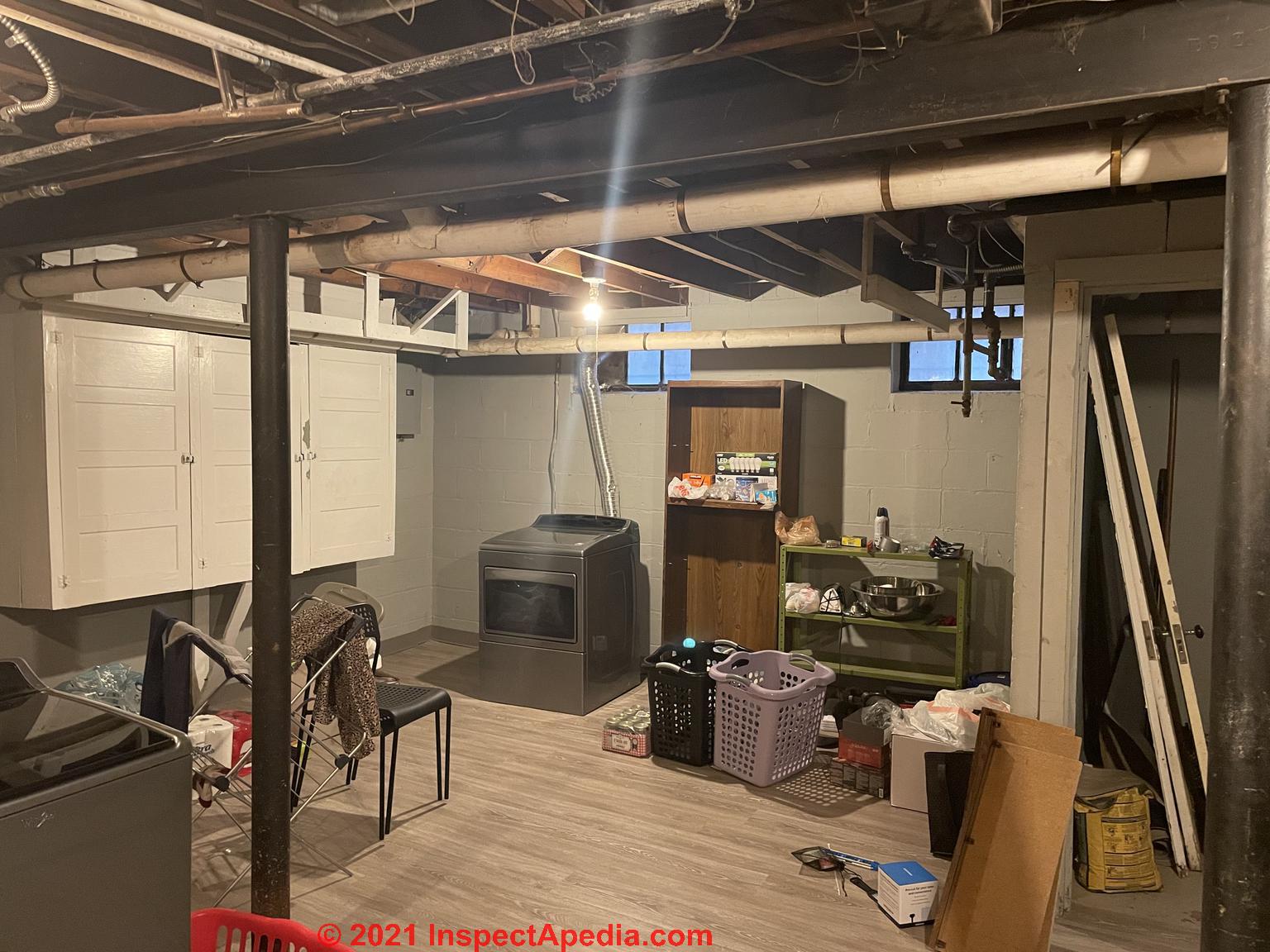
Hello Dan, Thanks for fielding these questions! I recently bought a home built in 1928 in Detroit that has Aircell asbestos wrap on the pipes coming off the boiler that seems to be in good shape.
The pipes run in two rooms in the basement and there's about 100' feet total of the asbestos wrapped pipe. I'm attaching a photo of the piping that's in a partially finished room in the basement that I believe was painted at some point so it looks a little worse than the unpainted wrap that's in the mechanical room.
I'm not sure if removal or encapsulation is a better option.
We had a licensed asbestos contractor out to have a look and he said we would be good candidates for either and encapsulation would cost about half as much, though we could still afford the removal costs.
The contractor seemed to lean towards removal since it'd just be gone and we wouldn't need to worry about it again. Would love to hear your thoughts!

On 2020-10-05 - by (mod) -
Glad to assist; Lots of family in Minneapolis; we'll be back in Two Harbors later this fall.On 2020-10-05 by Mark
Thank you Dan!
Mark, Minneapolis Minnesota
On 2020-10-05 by (mod) - encapsulate asbestos that can be left in place
Mark:
Asbestos that is in good condition can usually be left in place and encapsulated and protected from damage: generally that's recommended as safer and less costly.
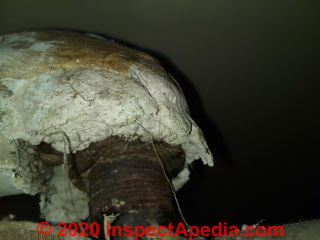 Usually when half the asbestos pipe lagging has fallen off of a pipe elbow (such as in your photo shown here) a remediator will have the view that the remaining material is not stable and not secure and will argue for removing at least that section of asbestos insulation as well as any other that is in similar condition.
Usually when half the asbestos pipe lagging has fallen off of a pipe elbow (such as in your photo shown here) a remediator will have the view that the remaining material is not stable and not secure and will argue for removing at least that section of asbestos insulation as well as any other that is in similar condition.
Proper removal of asbestos pipe insulation such as was often found on heating pipes involves
- setting up dust containment
- removing the material
- cleaning the surfaces left exposed
- sealing the cleaned surfaces
- installing suitable replacement insulation
- encapsulating any other asbestos insulation that's being left in place
- cleaning up the work area
- and for larger projects or if the dust containment was suspect or fell or failed, testing settled dust in surrounding areas to determine if further cleanup is needed.
There's no way such work is going to be done in just a few minutes.
On 2020-10-05 by Mark
Thank you Dan!
Since the asbestos is not "intact", does the asbestos need to be completely removed?
From OSHA 1926.1101(b) "removal" and "disturbance" of thermal system insulation asbestos defines the difference between Class I and Class III work and regulations.
On 2020-10-05 - by (mod) -
Yes, Mark
On 2020-10-02 by Mark
My radiator has a steam leak and we realized that there is exposed asbestos. The property manager claims that an asbestos abatement company can remove the asbestos in under an hour.
Is this "friable" asbestos?
Building management did not tell us the material was asbestos until we asked.
Is this reasonable?
-Mark Minneapolis Minnesota

On 2020-07-17 - by (mod) -
Curtis
Certainly it could be
On 2020-07-16 by Curtis
Hi, I’ve come across a big steam pipe 12” diameter with a Hamden wrapping. Between the steel pipe and silver coloured banded wrapping is a white powdered compound. It crumbles very easy. Is this a hard cast asbestos material? Is it highly likely to be asbestos? Pipe is from late 1960s
On 2019-10-23 - by (mod) - cellulose or wood fiber insulation is not asbestos
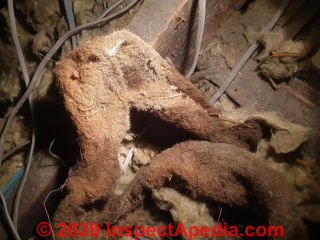 That looks like a wood fiber or some similar cellulosic insulating material
That looks like a wood fiber or some similar cellulosic insulating material
On 2019-10-23 by Lewis
What's this? Found in loft
On 2019-08-25 - by (mod) -
Thanks for a useful question, Kathy.
You probably don't actually have asbestos "pipes" - more likely asbestos-insulation on heating or water pipes, or less-likely, transite or cement/asbestos pipes sometimes used as a heating chimney or flue vent for gas fired equipment.
It'd help if you'd post a photo or two (one per comment) so I can see better what's going on.
For either of those situations, if the asbestos insulation
(to identify this see ASBESTOS PIPE INSULATION)
OR transite pipe
(to identify this see TRANSITE CHIMNEYS)
If the material is not in a location where it's likely to be damaged and / or disturbed, you could spray those exposed "ends" with any spray paint or sealant (or search InspectApedia.com for FUNGICIDAL SEALANTS & PAINTS) or similar encapsulants in several coatings so that there are no loose fibres that can become airborne.
Asbestos is safe and legal to remain in homes or public buildings as long as the asbestos materials are in good condition and the asbestos can not be released into the air. - US EPA
On 2019-08-25 by KathyDeFelice
I have some old asbestos pipes in my cellar from an old heating system. The bilk of them are still in decent shape but there are exposed ends where the pipes were cut. I cannot afford removal.
What is the best and safest way to cover these pipes and exposed ends? I need to refinance my house and need to take care of this before inspection.
On 2019-07-19 - by (mod) -
That looks to me like an asbestos material, either heavy paper or cementious transite asbestos pipe.
Treat it as presumed to contain asbestos or have a sample tested.
Related questions:
Where is the building: country and city?
How old is the building;
What was this pipe used for? Ducts? Drainage? Heating flue?
If you have test keep us posted.
On 2019-07-19 by kat
I have a sketchy looking pipe with damaged insulation in my basement ceiling. Does this have any telltale signs of asbestos?
On 2019-04-05 - by (mod) -
Vincent
Naturally I can't see much of the properties of the material you describe from my desk here in Mexico,
But if the stuff is asbestos it sounds as if professional cleanup would be in order. Asbestos was still being used in U.S. construction (you don't give your country and city) up to the mid 1980s in one form or another.
You could try the Add Image button to post a sharp photo or two - one per comment.
On 2019-04-05 by Vincent
Hello, I work in a commercial building that started construction in 1980 and opened for occupancy in 1987. While in the basement level the other day, I noticed large, rounded, solid white chunks that seemed to have fallen off an overhead pipe onto the floor. It looks somewhat like asbestos magnesia pipe insulation, but more sturdy and concrete-like.
I was unable to take pictures or get a close look. Could this be asbestos containing material? When was asbestos pipe insulation, both air-cell and magnesia, discontinued from construction of new buildings? Could this debris be ACM? Thanks!
On 2018-12-29 - by (mod) -
Well you might-have. Just how much concern you should have isn't something one can guess by e-text; you could check with your doctor about your general health vulnerability.
You could test a sample of settled dust, and your basement asbestos pipe insulation, if it's generally sound, may still want encapsulation.
Don't stir up more dust.
On 2018-12-29 by Ken
HI, I have asbestos insulation on basement piping and it looks like a huge pile of dust or asbestos seeping out of it. For some reason I swept the basement floor ...kicking up a lot of dust and am now worried I may have inhaled asbestos.
any thoughts? should I be worried or not?
On 2019-01-15 by (mod) - fiberglass insulating pipe wrap
Mama
The photo is a bit blurry but to me your image of pipe insulation looks like yellow fiberglass insulation.
On 2019-01-15 by Mamabear710
Can someone tell me if this is exposed asbestos? It's supposed around what seems to be a hot water pipe.
On 2019-01-01 by (mod) -
Old
What's this asbestos pipe, probably transite cement which contains asbestos, actually doing? If it's moving house are it's an asbestos Hazard if it's venting flue gases that sounds like a safety hazard.
On 2018-12-31 by Old home owner
My floor furnace has an aspestos vent pipe that runs under the house and next to the chimney. It has been knocked loose and repositioned several times by plumbers and my roofer. Should I have it checked?
On 2018-11-12 by (mod) - more fiberglass pipe insulation
Fiberglass covered with something i cant ID
On 2018-11-12 by Steveinsul
Thanks again for your help.
On 2018-11-12 by (mod) -
Thank you for the added detail. Perhaps you can show me in a couple of more detailed and sharp photos.
On 2018-11-12 by Steveinsul
What I have is a dark green plastic wrapping over what looks like a fiberglass but the fiberglass-like material (visible in pic where wrap meets copper pipe) feels softer than fiberglass in other parts of house, so wasn’t sure what it was.
On 2018-11-12 by (mod) - black foam insulating jacket will not be asbestos
A black foam insulating jacket will not be asbestos.
On 2018-11-12 by Steveinsul
The pipe has what looks like an insulating jacket on it. Not sure it’s fiberglass in there, but was curious if the type of insulating jackets contained asbestos from 1977 when house was built.
On 2018-11-12 by (mod) -
Looks like some kind of spray over spray on foam insulation
On 2018-11-12 by Steveinsul
House built in 1977. This insulation wrap is on water pipe near valve where outside faucet is. This pipe is located in basement adjacent to outside wall.
On 2018-11-01 by (mod) -
Vincent
Thank you for the important question.
You are right, most of the asbestos use world wide was of the Chrysotile or serpentine (curly fiber) form.
I thought I had reviewed and corrected this point.
I have reviewed and clarified the article at
ASBESTOS PIPE INSULATION - the home page for this topic.
On 2018-11-01 by Vincent
The article states that most corrugated asbestos pipe insulation worldwide was made of crocidolite. Was this also true in the United States? My understanding is that chrysotile was the primary fiber type used in 95 percent of applications in the US. Thanks!
On 2018-08-13 by (mod) -
Dan
That could be a stick caulk-like pipe wrap - some of which contained asbestos depending on age of production.
It would be helpful to know the age of the building, piping, and when the wrap was installed.
To keep your photo in view and to invite comments from other readers I will repeat your question, your photo, and a longer reply at
ASBESTOS PIPE INSULATION - the home page for this topic.
Continuing...
I agree that the black stuff looks like mold growth.
The pipe wrap appears to be intact and not shedding.
The safest, least-costly and most-recommended approach (including by US EPA) is to leave such insulation in place, undisturbed, covering or encapsulating it.
The only down-side is that some day if a section of pipe has to be repaired it has then to be handled with appropriate care.
If your pipe insulation is what it looks like, originally it had a sticky surface - it's not likely to be shedding if left alone. I'd encapsulate it.
On 2018-08-12 by Dan
Are these copper water pipes wrapped with asbestos? They are hidden above the drop ceiling in the basement.
The house was built in 1973 in Maryland. Another question is about what appears to be black mold on the wrap. I am assuming that either way, we're going to have to get a proffessional to remove this, correct?
Question: is this asbestos insulation and is it dangerous?
2018/04/11 Antonio said:
Is this asbestos on my pipes - I'm really scared. [paraphrasing from private email]
Reply:
I looked at your photos - they look like asbestos lagging or paste on pipes.
Rather than being very scared, it would be prudent to avoid disturbing the material and to either encapsulate it in place or have it removed professionally.
Watch out: while asbestos in good condition is usually left alone or simply encapsulated (if you avoid making a dusty mess the hazards to building occupants from the material, left alone, in place, undisturbed, are minimized) your case is different.
For asbestos pipe insulation that is in poor condition, falling off, or especially when it is an area accessed by people, it is beyond encapsulation and needs to be removed by a professional.
On 2017-12-13 by (mod) - what to do about asbestos-suspect materials
Nick, I don't have much context around the photo but this looks like it might be a lagging or paste type asbestos pipe cover, in poor condition. If we knew the age of the building and more of the context: what's around, that might help.
I would not disturb the material nor do any messy demolition/removal without either assuming the material contains asbestos, or if faced with a high removal cost, have a sample tested.
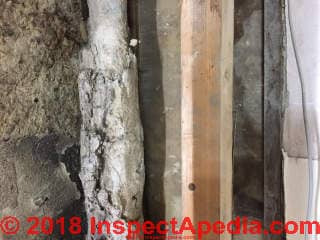 Search InspectApedia.com
Search InspectApedia.com
for ASBESTOS TESTING LAB LIST if that's needed.
On 2017-12-13 by Nick
I came across this today hidden in some boxing, looks very suspicious and it's not bee picked up on the asbestos register.
Any thoughts on what it could be.
Possible asbestos in Mesulite pipe insulation on a 1920's home?
I have just found some old insulation lagging to iron pipes in my loft of a 1920's house; it has the name "Melsulite" branded on the outer face and an imperial measurement alongside;
whilst it looks like a "modern" lagging material as it is foam like and fitted in loose sections like normal lagging, its age and the imperial reference suggests that it may be of some vintage, possibly original and, therefore, may well contain asbestos.
Any comments would be very welcomed. On 2016-08-25 by Howard Johnson
Reply by mod
I don't know.
Possibly your pipe insulation was made from mesolite. Mesolite is one of about thirty fibrous zeolite minerals. Mesolite was mined in Canada, France, Iceland, India, and the U.S.
It's possible that that fibrous mineral was used as insulation in the 1920s. More commonly these materials are used as a catayst or an adsorber or ion exchange medium.
Watch out: Mesolite is cited among potentially hazardous natural mineral fibers in this WHO article
WHO, ASBESTOS AND OTHER NATURAL MINERAL FIBRES Environmental Health Criteria 53 [PDF] (1986) copy on file as Asbestos-and-Other-Mineral-Fibres-WHO.pdf
Gray corrugated pipe looks like Aircell - asbestos?
Hello,
I noticed a pipe at a local business I often go to that had damaged insulation looking like gray corrugated cardboard. I
asked the proprietor about it who said they had that specific pipe's insulation tested when it broke at another joint years earlier. They were surprised to hear it was asbestos-free and 'just cardboard'.
I can't help but think it looks just like the Aircell (gray, corrugated) and you say visual identification can be a virtual certainty. Is it possible this is some Aircell-lookalike material? Thank you. On 2016-02-06 by fortwaynemark
by (mod) -
Fort
I'm surprised. Age and appearance of heating pipe insulation matching the page top photo of this ASBESTOS PIPE INSULATION article are rather reliable indicators.
I'm not aware of a non-Asbestos lookalike.
I can't know just what you saw and would sure like to see some sharp photos as well as to know the age of the building, it's heating and it's heat piping systems.
Can my steam boiler be replaced if I have asbestos insulation on the pipes
Can my steam boiler be replaced if I have asbestos insulation on the pipes? In other words, can it be replaced without disturbing the pipes, or will the insulation have to be removed/replaced before I can have the boiler replaced? On 2015-12-30 by Kelly
Answer by (mod) - yes - add cost for asbestos removal
Yes certainly, Kelly, though there will be an additional cost to remove at least enough asbestos to permit workers to make proper connections to the existing building steam piping.
There is no justification for a complete asbestos pipe insulation removal job just to replace the boiler; however if the pipe insulation in other areas not right at the boiler is not in good condition or is in an area likely to be disturbed then it probably needs removal. Usually it's best to leave asbestos in good condition alone, or to encapsulate it.
OK to seal asbestos-insulated pipes with spray-foam?
Could i use closed cell spray foam to completely encapsulate asbestos covered radiator pipes ? - On 2015-11-15 by Duane
Caveat by (mod) - doubtful approach
Duane
That's not an approach I've seen used, I suspect because it's not practical - your foam will ooze all over the place and drop in blobs onto the floor.You'd have to box-in the pipes and then fill the box with foam;
...
Continue reading at ASBESTOS PIPE INSULATION - home, or select a topic from the closely-related articles below, or see the complete ARTICLE INDEX.
Or see ASBESTOS PIPE INSULATION FAQs-2 - more-recent Q&A about recognizing and dealing with asbestos-suspect pipe insulation
Or see these
Recommended Articles
- ASBESTOS in GOOD CONDITION
- ASBESTOS in POOR CONDITION
- ASBESTOS REMOVAL, AMATEUR
- ASBESTOS on HEATING BOILERS
- ASBESTOS PIPE INSULATION - home
- ASBESTOS TESTING LAB LIST
- CEMENT ASBESTOS PIPE MANUFACTURE
- HISTORY & DATES OF ASBESTOS CONTAINING MATERIAL BANS & REGULATIONS
Suggested citation for this web page
ASBESTOS PIPE INSULATION FAQs at InspectApedia.com - online encyclopedia of building & environmental inspection, testing, diagnosis, repair, & problem prevention advice.
Or see this
INDEX to RELATED ARTICLES: ARTICLE INDEX to ASBESTOS HAZARDS
Or use the SEARCH BOX found below to Ask a Question or Search InspectApedia
Ask a Question or Search InspectApedia
Try the search box just below, or if you prefer, post a question or comment in the Comments box below and we will respond promptly.
Search the InspectApedia website
Note: appearance of your Comment below may be delayed: if your comment contains an image, photograph, web link, or text that looks to the software as if it might be a web link, your posting will appear after it has been approved by a moderator. Apologies for the delay.
Only one image can be added per comment but you can post as many comments, and therefore images, as you like.
You will not receive a notification when a response to your question has been posted.
Please bookmark this page to make it easy for you to check back for our response.
IF above you see "Comment Form is loading comments..." then COMMENT BOX - countable.ca / bawkbox.com IS NOT WORKING.
In any case you are welcome to send an email directly to us at InspectApedia.com at editor@inspectApedia.com
We'll reply to you directly. Please help us help you by noting, in your email, the URL of the InspectApedia page where you wanted to comment.
Citations & References
In addition to any citations in the article above, a full list is available on request.
- In addition to citations & references found in this article, see the research citations given at the end of the related articles found at our suggested
CONTINUE READING or RECOMMENDED ARTICLES.
- Carson, Dunlop & Associates Ltd., 120 Carlton Street Suite 407, Toronto ON M5A 4K2. Tel: (416) 964-9415 1-800-268-7070 Email: info@carsondunlop.com. Alan Carson is a past president of ASHI, the American Society of Home Inspectors.
Thanks to Alan Carson and Bob Dunlop, for permission for InspectAPedia to use text excerpts from The HOME REFERENCE BOOK - the Encyclopedia of Homes and to use illustrations from The ILLUSTRATED HOME .
Carson Dunlop Associates provides extensive home inspection education and report writing material. In gratitude we provide links to tsome Carson Dunlop Associates products and services.


